
Τράπεζα Ἰδεῶν
Θησαύρισμα ἰδεῶν καί ἀναφορῶν γιά τήν Ὀρθοδοξία καί τόν Ἑλληνισμό
info@tideon.org

Η ψυχή μας είναι εικόνα του Θεού, όταν όμως τη μολύνουμε με αμαρτία, τι κάνουμε τότε; Ρίχνουμε την εικόνα του Θεού στον βόρβορο. Ω ψυχή μας, πόσο σε καταφρονούμε! Ω Θεέ, πώς υπομένεις τέτοια καταφρόνηση! Τιμούμε την εικόνα ενός βασιλιά ή άρχοντα και δεν τιμούμε την ψυχή μας στην οποία χάραξες Εσύ την εικόνα Σου. Τίποτε δεν είναι πολυτιμότερο της ψυχής, και όμως για μία εφήμερη απόλαυση ή για πρόσκαιρη τιμή ή γι’ απόκτηση λίγου πλούτου πωλούμε την ψυχή μας, τον πολύτιμο αυτό θησαυρό.
Αν είχαμε πολλές ψυχές θα μας έμενε άλλη, αλλ’ εμείς έχουμε μία και μόνη ψυχή, για την οποία έγιναν τα ουράνια και τα επίγεια, για την οποία κοπιάζει η φύση, κινείται ο ουρανός, λάμπει ο ήλιος, καρποφορεί η γη, γεννιούνται τα φυτά και τα ζώα, και για την οποία κτίστηκε ο Παράδεισος, ετοιμάστηκε η Βασιλεία των ουρανών, η ατελεύτητη μακαριότητα, η απέραντη δόξα και όλα εκείνα τα αγαθά της αιώνιας ζωής «α οφθαλμός ουκ είδε, και ους ουκ ήκουσε και επί καρδίαν ανθρώπου ουκ ανέβη» (Α’ Κορ. 2:9). Και αν χάσουμε την ψυχή μας, χάνουμε τα πάντα: και γη και ουρανό, και κόσμο και Παράδεισο, και αυτή την πρόσκαιρη ζωή και την αιώνια.
Για να δοκιμάσει ο Θεός την υπομονή του δικαίου Ιώβ, έδωσε άδεια στον Διάβολο να τον πειράξει, να τον ζημιώσει, να τον λυπήσει και να τον βλάψει στα πλούτη του, στα παιδιά του, στην υγεία του, την ψυχή του όμως να μην αγγίξει! «Ιδού πάντα όσα εστίν αυτώ δίδωμί σοι, πλην την ψυχήν αυτού διαφύλαξον». Έγινε φτωχός εν ριπή οφθαλμού ο πλουσιότατος Ιώβ, τα αναρίθμητα ζώα, μικρά και μεγάλα κατακάηκαν, τα ψηλά παλάτια γκρεμίστηκαν από βίαιη πνοή ανέμου, τα παιδιά του σε μια ώρα έλαβαν πρόωρο και αιφνίδιο θάνατο, αυτός φτωχός, έξω από την πόλη πληγιασμένος από το κεφάλι ως τα πόδια, κείτονταν στην κοπριά, την ημέρα να φλογίζεται από τον καύσωνα του ηλίου, τη νύκτα να βασανίζεται από τον παγετό. Ο Ιώβ έχασε τα πάντα.
Ο Ιώβ, όχι, δεν έχασε απολύτως τίποτε, διότι δεν έχασε την ψυχή του. Τι λέει; Έχασα τα πλούτη μου; Αλλ’ εγώ γυμνός γεννήθηκα, τι το παράδοξο αν πεθάνω γυμνός; «Γυμνός εξήλθον εκ κοιλίας μητρός μου, γυμνός και απελεύσομαι εκεί». Έχασα τα παιδιά μου; Αλλά «ο Κύριος έδωκεν, ο Κύριος αφείλετο». Έχασα την υγεία μου; Έτσι άρεσε στον Θεό μου, «ως τω Κυρίω έδοξεν, ούτω και εγένετο». Έχασα τα πάντα, και δεν έχασα τίποτα, διότι η ψυχή μου έμεινε ακέραιη, παρ’ όλες τις δοκιμασίες είμαι δίκαιος ενώπιον του Θεού και γι’ αυτό δοξάζω, ευχαριστώ και ευλογώ το άγιο όνομά Του. «Είη το όνομα Κυρίου ευλογημένον!» (Ιώβ κεφ. 1-2)
Πόση πρόνοια έχει ο φιλάνθρωπος Κύριος όταν παραχωρεί θλίψεις ή για να μας δοκιμάσει ή για να μας παιδεύσει δίνοντας άδεια στον διάβολο να μας πειράξει, να μας βλάψει σε όλα εκτός από την ψυχή μας! «Την ψυχήν αυτού διαφύλαξον». Να μη βλάψει την ψυχή, τη μονογενή αυτή θυγατέρα του Ιησού Χριστού, την κληρονόμο της Βασιλείας Του, την οποία μάλιστα παραδίδει σε άγγελο φύλακα να τη σκέπει, να τη φυλάγει «από φόβου νυκτερινού, από βέλους πετομένου ημέρας, από πράγματος εν σκότει διαπορευομένου, από συμπτώματος δαιμονίου μεσημβρινού» (Ψαλ. 90:5-6). Και γιατί; Διότι όλα τα άλλα –λέει ο ιερός Χρυσόστομος– πρώτον, είναι πολλά, και αν λείψει το ένα, μένει το άλλο, «οπότερον τούτο βλαβή, δια του ετέρου την χρείαν παραμυθούμεθα», και δεύτερον, αν τα χάσουμε σήμερα, μπορούμε να τα βρούμε αύριο, όπως τα βρήκε όλα διπλά ο Ιώβ. Η ψυχή όμως είναι μία και αν τη χάσουμε χάθηκαν τα πάντα· «εάν ταύτην απολέσωμεν, εν τίνι βιοτεύσωμεν;»
Αν εμείς έχουμε ένα μονάκριβο παιδί, πόση είναι η φροντίδα μας να μη το βλάψει, να μη το πικράνει κανείς, παρά το ότι δεν εξαρτάται από αυτό η σωτηρία μας; Επίσης αν έχουμε έναν πολύτιμο λίθο, τον φυλάμε με πολύ επιμέλεια, παρά το ότι με αυτόν δεν μπορούμε να αγοράσουμε τον Παράδεισο. Την ψυχή μας όμως αν τη χάσουμε σε τίποτα δεν θα ωφεληθούμε, διότι γι’ αυτή ζούμε οι άνθρωποι στον κόσμο και με αυτή ελπίζουμε να ζήσουμε στον Παράδεισο. Αν τη χάσουμε, χάθηκαν τα πάντα, και τότε; «Εάν ταύτην απολέσωμεν, εν τίνι βιοτεύσωμεν;»
Της ψυχής μας το μεγάλο προνόμιο είναι ότι είναι αθάνατη. Ο μάταιος και φθαρτός κόσμος με καθετί ωραίο, καλό και πολύτιμο κάποτε θα έχει τέλος. «Παράγει γαρ το σχήμα του κόσμου τούτου» (Α’ Κορ. 7:31). Αργά ή γρήγορα θα έρθει ο θάνατος που σε όλα φέρνει το τέλος. Ό,τι και αν έχουμε στον κόσμο αυτό, όλα ή χάνονται ή εγκαταλείπονται, διότι «πάσα σαρξ ως χόρτος και πάσα δόξα ανθρώπου ως άνθος χόρτου, εξηράνθη ο χόρτος και το άνθος αυτού εξέπεσε» (Α’ Πέτρ. 1:24), η ψυχή μας μόνο μένει αθάνατη, ζει αιώνια, δεν πεθαίνει ποτέ. Ποιο λοιπόν το όφελος αν κερδίσει ο άνθρωπος τον κόσμο όλο που κάποτε θα τελειώσει, ενώ είναι μεγάλη η ζημία αν χάσει την ψυχή του που μένει στον αιώνα; Αν ο άνθρωπος χάσει την ελευθερία μπορεί να την εξαγοράσει, αν χάσει υγεία είναι δυνατό να θεραπευθεί, αν χάσει και τη ζωή του ακόμη, μπορεί να αναστηθεί, αλλά αν χαθεί η ψυχή δεν υπάρχει εξαγορά.
Του Παραδείσου τα κλειδιά ο Θεός τα παρέδωσε σε χέρια ανθρώπων· «καί δώσω σοι –είπε στον Πέτρο και σε όλους τους Αποστόλους– τας κλεις της βασιλείας των ουρανών» (Ματθ. 16:19). Του Άδη τα κλειδιά δεν τα έδωσε σε άνθρωπο, ούτε σε άγγελο, αλλά τα κράτησε ο ίδιος ο Θεός, όπως το λέει στην Αποκάλυψη: «καί έχω τας κλεις του άδου» (Απ. 1:18). Και γιατί τα κλειδιά του Παραδείσου, που είναι το ανάκτορο του Θεού, το βασιλικό παλάτι της δόξας, τα έδωσε σε χέρια ανθρώπων, και τα κλειδιά του Άδη που είναι η φοβερή φυλακή του εξωτέρου σκότους, το βασανιστήριο των κολαζομένων ψυχών, τα κράτησε ο ίδιος ο Θεός, ο Βασιλεύς και Κύριος; Για να μάθουμε ότι σε αυτή τη ζωή, όταν θελήσουμε να ανοίξουμε τον Παράδεισο για να ασφαλίσουμε μέσα εκεί την ψυχή μας, εύκολο είναι να βρούμε τα κλειδιά. Τα έχει παραδώσει σε ανθρώπους εδώ κάτω στη γη, αν τα ζητήσουμε τα βρίσκουμε στα χέρια κάθε πνευματικού πατρός. Αλλά αν έρθει αιφνίδιος ή φυσικός θάνατος και μας βρει ή φορτωμένους από τα βάρη του κόσμου, ή δεμένους με τις αλυσίδες της αμαρτίας και πεθάνουμε αδιόρθωτοι, αμετανόητοι, ανεξομολόγητοι, ακοινώνητοι, πού θα βρούμε τα κλειδιά του Άδη για να ελευθερώσουμε τη φυλακισμένη ψυχή μας; Άνθρωπος δεν τα έχει, άγγελος δεν τα παρέλαβε, τα κρατά ο ίδιος ο Θεός. Ο Κριτής τότε δεν δείχνει έλεος, δεν ανοίγει, διότι κλείστηκε η θύρα. Ελπίδα ελευθερίας δεν υπάρχει, διότι στον Άδη δεν υπάρχει μετάνοια.
Αλλά, ψυχή, είσαι το τελειότερο και ωραιότερο πλάσμα, διότι είσαι εικόνα τού Θεού, είσαι το πολυτιμότερο κτήμα, διότι είσαι αθάνατη. Ο εσταυρωμένος Ιησούς, ο Υιός του Θεού του ζώντος, έχυσε το ατίμητο αίμα Του για να σε εξαγοράσει, έδωσε την κολυμβήθρα του αγίου βαπτίσματος για να σε πλύνει, διέταξε άλλο, «δεύτερο βάπτισμα», τη μετάνοια, για να σε καθαρίσει, ετοίμασε την τράπεζα των αχράντων μυστηρίων Του για να σε θρέψει, έκτισε εδώ στον κόσμο Εκκλησία για να σε αγιάσει, εκεί δε Παράδεισο για να ζήσεις με μακαριότητα στους αιώνες των αιώνων.
Ό,τι ήταν δυνατό το έκανε η άκρα αγαθότητα και ευσπλαχνία Του για να σώσει τις ψυχές μας, και εμείς κάνουμε ό,τι μας υπαγορεύει η άκρα κακία μας για να τη χάσουμε. Είναι όμως προτιμότερο να χάσουμε καθετί που προσφέρει ο κόσμος και να κερδίσουμε την ψυχή μας· διότι, «τι ωφελήσει άνθρωπον εάν κερδίση τον κόσμον όλον και ζημιωθή την ψυχήν αυτού; ή τι δώσει άνθρωπος αντάλλαγμα της ψυχής αυτού;» (Ματθ. 16:26).
Πηγή: (Από το περιοδικό «Όσιος Φιλόθεος της Πάρου» 16, σελ. 47), Κοινωνία Ορθοδοξίας

Πνευματική ζωή. Τί νά εἶναι ἄραγε;
Πνευματική ζωή. Ἕνας ὁρισμός ζωῆς, πού ὁρίζει τίς ζωές μας. Πῶς ὁρίζεται ἄραγε ἡ πνευματική ζωή; Μήπως σάν ζωή γιά τήν τέχνη, τήν ἐπιστήμη, τά γράμματα, τόν πολιτισμό, τή θρησκεία; Ἔννοιες ὄμορφες πλήν ὅμως καί ἄμορφες; Παίρνουν μορφή ἀπό τό περιεχόμενο καί τόν στόχο τοῦ κάθε ἀνθρώπου. Ὁ πολιτισμός, ἡ τέχνη, ἡ ἐπιστήμη, ἡ θρησκεία εἶναι ἐργαλεῖα πού στά χέρια ἀνθρώπων μέ πνεῦμα ἀλλά χωρίς Πνεῦμα ἀποτέλεσαν ὄπλα μαζικῆς καταστροφῆς τῆς ἀνθρώπινης ζωῆς καί ἀξιοπρέπειας. Κατέστρεψαν ἀνθρώπους, οἰκογένειες, ἔθνη ὁλόκληρα.
Πνευματική ζωή. Ἕνας ὁρισμός ζωῆς πού ὅρισε τίς ζωές πολλῶν ἀνθρώπων. Ἀνθρώπων τοῦ Πνεύματος, τῶν γνήσιων φίλων τοῦ Θεοῦ καί τοῦ ἀνθρώπου, τῶν ἁγίων ἀλλά καί ἀνθρώπων τοῦ «πνεύματος» πού μᾶς ἀπογοήτευσαν μέ τό ἐπίπλαστο καί τό ἐκκωφαντικά ἄδειο τῆς ζωῆς τους. Πνευματική ζωή. Ἕνας ὁρισμός ζωῆς. Ἴσως καί τῆς δικῆς μας ζωῆς. Ἴσως ψευδαίσθηση μιᾶς τέτοιας ζωῆς. Ἴσως πόθος ζωῆς ἀπραγματοποίητος.
Πνευματική ζωή. Ἕνας ὁρισμός ζωῆς τόσο συγκεχυμένος, τόσο ἀφηρημένος ἀλλά καί τόσο καθοριστικός γιά τό παρόν καί τό μέλλον μας, γιά τήν ποιότητα ζωῆς μας, γιά τήν ποιότητα τῶν σχέσεών μας. Κάθε της στιγμή ὁρίζει τό εἶναι μας, τό « γιατί καί τό διότι» τῆς ὕπαρξής μας. Ἕνας ὁρισμός ζωῆς πού δοκιμάζεται καί καθορίζεται κάθε στιγμή τῆς ζωῆς μας, στήν κάθε σκέψη καί τήν κάθε πράξη της.
Εἶναι ἔρωτας.
Ἄν τολμοῦσα νά διατυπώσω ἕναν ὁρισμό τῆς πνευματικῆς ζωῆς θά ἔλεγα ὅτι ἡ πνευματική ζωή εἶναι ἕνας ἀέναος ἐρωτικός διάλογος, μία ἀμετάπτωτη ἐρωτική κίνηση, ἀνάμεσα στόν Θεό πού συνεχῶς κινεῖται ἐρωτικά πρός τό πλάσμα του, καί τόν ἄνθρωπο πού συνηθίζει νά κινεῖτε ἐρωτικά πρός τά δῶρα τοῦ Θεοῦ, τή δημιουργία, τό ὑλικό σύμπαν, τόν ἐμπαθῆ ἑαυτό του. Λατρεύει τήν κτίση καί ὄχι τόν Κτίστη. Ὁ ἄνθρωπος ἔχει ἀνάγκη νά ἐνεργοποιεῖ σῶμα, νοῦ, ψυχή καί καρδιά σέ ὅ,τι θεωρεῖ ὅτι ἱκανοποιεῖ τίς ψυχοσωματικές ἀνάγκες του. Ὅ,τι δηλαδή θεωρεῖ σάν πηγή ζωῆς, δύναμη πραγματοποίησης τῶν ἐπιθυμιῶν του. Τό μυστικό ὅμως στήν πνευματική ζωή τό ἔδειξε μέ τό παράδειγμά Του ὁ Θεάνθρωπος Ἰησοῦς. Μποροῦσε νά πραγματοποιήσει κάθε ἀνάγκη Του καί κάθε ἐπιθυμία, ἀφοῦ ἦταν ἑνωμένος μέ τήν Θεότητα, ἐντούτοις ἀφέθηκε ἕρμαιο στήν κακία καί τό μίσος τῶν ἀνθρώπων. Θέλοντας νά δείξει πώς ὁ δρόμος γιά τήν ὁλοκλήρωση τοῦ ἀνθρώπου δέν εἶναι ἡ στροφή πρός τόν ἑαυτό του καί τίς ἐπιθυμίες του, ἀλλά τό ἄδειασμα, ἡ κένωση τοῦ ἑαυτοῦ, ἡ θυσία, ὁ πόνος, ὁ ἔρωτας, ἡ ἀγάπη. Μόνο ἕνας ἐρωτευμένος μπορεῖ νά δεῖ πώς ὑπάρχει χαρά στήν θυσία καί στόν πόνο. Ἀπό τήν ἄλλη μεριά, μόνο ἕνας πού πόνεσε γιά κάποιον. Μόνο ἕνας πού συνειδητά ὑπέμεινε τίς ἀδυναμίες ἀκόμη καί τήν ἄδικη συμπεριφορά τοῦ ἄλλου, συνεχίζοντας νά τόν ἀγαπᾶ, μπορεῖ νά πεῖ τί εἶναι ἔρωτας καί ἀγάπη. Καί κυρίως μόνο ἕνας πού θυσίασε κάτι ἀπό τόν ἑαυτό του καί τίς ἐπιθυμίες του, προκειμένου νά κερδίσει αὐτόν, πού ἀγαπᾶ, μπορεῖ νά πεῖ ὅτι πραγματικά γεύτηκε τόν ἔρωτα.
Αὐτός εἶναι ὁ Θεός μας πού χωρίς νά χάσει αὐτό πού ἦταν (Θεός) ἑνώθηκε μέ αὐτό πού δέν ἦταν (ἄνθρωπος). Καί ἀπό τότε μπορεῖ τό κτίσμα (ὁ ἄνθρωπος) νά ἑνώνεται μέ τό ἄκτιστο (τίς ἄκτιστες ἐνέργειες τοῦ Θεοῦ). Σέ τέτοιο ἐπίπεδο ἀνεβάζει τόν ἄνθρωπο ὁ ἔρωτας τοῦ Θεοῦ πρός τόν ἄνθρωπο, ἐάν βέβαια ὁ ἄνθρωπος ἀνταποκριθεῖ σέ αὐτό τό ἐρωτικό κάλεσμα τοῦ Θεοῦ.
Αὐτό πού λέει ὁ ἐρωτευμένος στήν ἀγαπημένη του «σέ λατρεύω» καί δέν χορταίνει νά τό λέει, κάθε ὥρα καί στιγμή εἶναι ὁ ὁρισμός τῆς πνευματικῆς ζωῆς ὡς λατρείας τοῦ Θεοῦ. Ὅταν ὁ ἐρωτευμένος λέει καί ξαναλέει «σέ ἀγαπῶ» γεννιοῦνται μέσα του τέτοια αἰσθήματα χαρᾶς, τόση εὐφροσύνη πού νοιώθει σάν νά ζεῖ ἀπό τώρα στόν παράδεισο. Τά ἴδια αἰσθήματα πρός τόν Θεό ἔνοιωσαν οἱ ἅγιοί μας, ὁ Μέγας Βασίλειος, ὁ Ἰωάννης ὁ Χρυσόστομος καί αὐτά τά αἰσθήματα τά μετέφεραν σέ λόγια λατρευτικά.
Δέν μπορεῖ νά βιωθεῖ ἡ θεία Λειτουργία, παρά μόνο ἄν ἰδωθεῖ μέσα ἀπό τό πρίσμα τοῦ ἐρωτευμένου, πού ἀπευθύνει λόγια λατρείας στόν ἀγαπημένο του Θεό. Τό «Κύριε ἐλέησον», ἡ μονολόγιστη εὐχή «Κύριε Ἰησοῦ Χριστέ, ἐλέησόν με» δέν εἶναι τίποτε ἄλλο παρά ἡ μέ πόνο ἐκζήτηση συγνώμης ἑνός ἐρωτευμένου πού ἀνακαλύπτει ὅτι πλήγωσε Αὐτόν πού τόσο τόν ἀγάπησε πού ἔδω- σε ἀκόμη καί τήν ἴδια τή ζωή Του. Αἰσθήματα εὐγνωμοσύνης, θαυμασμοῦ, δικῆς μας ἀνεπάρκειας μπροστά στό μέγεθος τῆς ἀγάπης Του, τῆς ἀνεκτικότητάς Του, τῆς ἀνεξικακίας Του, τῆς συνεχοῦς προσφορᾶς Του στή ζωή μας, εἶναι αἰσθήματα ὑγιοῦς πνευματικῆς ζωῆς ἀλλά καί αἰσθήματα κάθε ὑγιοῦς ἐρωτικῆς σχέσης.
Γενικότερα δέν μπορεῖ νά κατανοήσει κανείς τήν στάση ἑνός μάρτυρα, ἑνός ἀσκητῆ, ἑνός ἁγίου οἰκογενειάρχη, ἑνός ἁγίου μοναχοῦ, ἄν δέν τή δεῖ σάν ὑπέρβαση μέ κίνητρο τόν ἔρωτα. Εἶναι αὐτό πού λέμε θεῖος ἔρωτας. Καί ἐν γένει ἡ πνευματική ζωή, ἡ ἀπάρνηση τοῦ θελήματός μας, ἡ ἄσκηση, ἡ νηστεία, ἡ συγχώρηση τοῦ ἐχθροῦ, ἡ φιλαδελφεία καί ἡ ἐλεημοσύνη, εἶναι ὅλα παράλογα ἄν δέν τά δεῖ κανείς μέσα ἀπό τή χαρά τοῦ ἔρωτα, τό ἄνοιγμα καί τό ρίσκο πού παίρνει ἕνας ἐρωτευμένος γιά νά ἱκανοποιήσει τόν ἐραστή του. Τό δόσιμο τοῦ ἑαυτοῦ του χωρίς προϋποθέσεις, τήν ἠθελημένη αὐτοπαράδοση, τό «πᾶσαν τήν ζωήν παραθώμεθα» μόνο ἕνας ἐρωτευμένος ἔχει τήν δύναμη νά τολμήσει.
Ὅπως ἔλεγε ὁ Γέροντας Πορφύριος «Ἡ σχέση μὲ τὸν Χριστὸ εἶναι ἀγάπη, εἶναι ἔρωτας, εἶναι ἐνθουσιασμός, εἶναι λαχτάρα τοῦ θείου. Ὁ Χριστὸς εἶναι τὸ πᾶν. Αὐτὸς εἶναι ἡ ἀγάπη μας, αὐτὸς ὁ ἔρωτάς μας. Εἶναι ἔρωτας ἀναφαίρετος ὁ ἔρωτας τοῦ Χριστοῦ … Ἡ οὐσία εἶναι νὰ εἴμαστε μαζὶ μὲ τὸν Χριστό. Νὰ ξυπνήσει ἡ ψυχὴ καὶ ν’ ἀγαπήσει τὸν Χριστό, νὰ γίνει ἁγία. Νὰ ἐπιδοθεῖ στὸν θεῖο ἔρωτα…». Ὅτι λοιπόν κάνουμε στήν πνευματική ζωή, ὅπως ἐγκράτεια, νηστεία, μετάνοιες, ἐλεημοσύνη, ἄσκηση, προσευχή, θεία λατρεία, εἶναι ἡ ἀνταπόκριση στὸ ἐρωτικό κάλεσμα τοῦ Θεοῦ.
Εἶναι ἡ λαχτάρα μας νά ἑνωθοῦμε μαζί Του, νά τόν κοινωνήσουμε, νά τόν ἀγαπήσουμε. «Ἕνας νὰ εἶναι ὁ στόχος μας, ἡ ἀγάπη στὸν Χριστό, στὴν Ἐκκλησία, στὸν πλησίον. Ἡ ἀγάπη, ἡ λατρεία πρὸς τὸν Θεό, ἡ λαχτάρα, ἡ ἕνωση μὲ τὸν Χριστὸ καὶ μὲ τὴν Ἐκκλησία εἶναι ὁ ἐπὶ γῆς Παράδεισος».
Πῶς ξεκινάει αὐτή ἡ σχέση;
Ὅμως στήν πράξη πολλές φορές στρέφουμε τή λατρεία μας, τόν ἔρωτά μας στά δῶρα τοῦ Θεοῦ καί ὄχι στήν ἴδια τήν πηγή τῶν ἀγαθῶν, κάτι τό παράλογο καί ἀφύσικο. Αὐτό ἔχει ὡς ἀποτέλεσμα νά πληγωνόμαστε καί νά ἀπογοητευόμαστε ἀπό τούς ὅποιους ἔρωτές μας (χρῆμα, σαρκικές ἡδονές, φιλοδοξία). Ἐδῶ ἔχουμε δυό ἐπιλογές. Ἤ συνεχίζουμε στόν ἴδιο ἀδιέξοδο τρόπο ζωῆς ἤ τολμᾶμε νά κάνουμε τό ἄλμα καί νά δοῦμε κατάματα τόν ἑαυτό μας, ὅπως ἔχει, χωρίς ὡραιοποιήσεις καί δικαιολογίες, ἀλλά καί χωρίς αἴσθηση ἀπελπισίας. Ἀπό τή στιγμή πού ὁ ἄνθρωπος ἔχει τήν δύναμη νά βιώσει τήν πραγματική ἐμπειρία τοῦ ἑαυτοῦ του, κυρίως τίς ἀστοχίες του, τίς ἀποτυχίες του, τά ἀδιέξοδα πού τόν ὁδήγησαν οἱ ψεύτικες θεότητες καί λατρεῖες του, ἀρχίζει νά εἰσέρχεται στή σφαίρα τῆς πνευματικῆς ζωῆς ἤ τουλάχιστον στήν ἀναζήτησή της.
Αὐτό πού ἡ Ἐκκλησία ὁρίζει ὡς μετάνοια δέν εἶναι μία συναίσθηση ἐνοχῆς, οὔτε κἄν μεταμέλεια γι’ αὐτό πού σκεφτήκαμε ἤ πράξαμε, εἶναι κυρίως ἡ πλήρης καί ἀμετάθετη ἀποδοχή τῆς πνευματικῆς μας ἀνεπάρκειας καί τῆς πλήρους ἀποτυχίας μας νά ἀγαπήσουμε ἀληθινά τόν ἑαυτό μας, νά σχετιστοῦμε ἰσορροπημένα καί ἐπιτυχημένα μέ ὅ,τι μᾶς περιβάλλει, νά στρέψουμε τήν ἐρωτική ἐνέργειά μας πρός τόν Θεό. Μετά τήν ἀπογοήτευση ἀρχίζει ἕνας ἐσωτερικός διάλογος. Καί τότε σοῦ ἔρχεται ἡ ὄρεξη νά μιλήσεις μέ τόν Θεό πού τό νοιώθεις πώς ἄν καί τόν ξέχασες καί τόν πρόδωσες, εἶναι ἕτοιμος ἀνά πᾶσα στιγμή νά σοῦ μιλήσει. Ἀφοῦ σταυρώθηκε ἀκόμη καί γι’ αὐτούς πού τόν σταύρωσαν, δέν σοῦ «κρατᾶ καμία κακία», ἀλλά περιμένει μία σου κίνηση, ἕνα σκίρτημα τῆς ψυχῆς σου γιά νά σοῦ προσφέρει τήν ἀγάπη Του.
Σάν κραυγή ἀγωνίας, σάν προσευχή.
Ἔτσι ἀρχίζει ἕνας διάλογος μέ τόν Θεό στόν ὁποῖο βέβαια ὁ ἄνθρωπος συντετριμμένος ἀπό τήν «ἀρχοντιά» τοῦ Θεοῦ κρέμεται ἀπό τά χείλη τοῦ Ἀγαπημένου καί περιμένει νά ἀκούσει τί ἔχει νά τοῦ πεῖ καί ἀφήνεται μέ ἐμπιστοσύνη νά ὁδηγηθεῖ ἀπό Αὐτόν. Καί τότε ζητᾶ ἀπό τό Πανάγιο Πνεῦμα τό: «Ἐλθέ καί σκήνωσον ἐν ὑμῖν καί καθάρισον ὑμᾶς ἀπό πάσης κηλίδος». Νά ἔλθει δηλαδή τό Πνεῦμα τό Ἅγιο καί νά ἄρει τά ἐμπόδια, πού ἐμποδίζουν τή σχέση μέ τόν ἀγαπημένο κάθε καρδιᾶς, τόν Θεό. Ἄς ἀρχίσουμε νά τοῦ μιλᾶμε
Ἡ Πνευματική ζωή, ὅπως καί κάθε ἀγάπη, προϋποθέτει διάλογο. Ἕνα συνεχῆ, εἰλικρινῆ, ἀγαπητικό καί ἐρωτικό διάλογο μέ τόν Τριαδικό Θεό. Αὐτό πού λέμε προσευχή. Ἡ ποιότητα αὐτοῦ τοῦ διαλόγου καθορίζει τά πάντα στή ζωή μας. Μέ ὅση εἰλικρίνεια διαλεγόμαστε μέ τόν Θεό, μέ τέτοια εἰλικρίνεια διαλεγόμαστε μέ τόν ἑαυτό μας καί τό συνάνθρωπο. Ὅσο ἀγαπητικά διαλεγόμαστε μέ τόν Θεό τόσο ἀγαπητικά ἑνωνόμαστε μέ τόν ἑαυτό μας καί ὅ,τι μᾶς περιβάλλει.
Ἄν λοιπόν ψάχνουμε νά ἀγαπήσουμε πραγματικά τόν ἑαυτό μας, τούς ἀνθρώπους, τό περιβάλλον, ἄς ξεκινήσουμε ἕνα τέτοιο διάλογο. Ἄν θέλουμε νά συναντήσουμε τήν ἐλπίδα, τή χαρά, τό φῶς, τήν ἐλευθερία, ἄς ἀρχίσουμε νά τοῦ μιλᾶμε. Ἄς ἀνοίξουμε τήν καρδιά μας σέ λατρευτική κοινωνία μέ τόν Θεό καί τόν κάθε ἄνθρωπο, πού εἶναι δίπλα μας, στήν οἰκογένειά μας, στήν Ἐκκλησία καί στήν ἐργασία. Ἄς πάρουμε τά ὑπέρλογα ρίσκα ἑνός ἐρωτευμένου πού παραθεωρεῖ τά πάντα, δέν τόν νοιάζει ἄν πεινάσει, δέν δέχεται περιορισμούς στήν ἔκφραση τοῦ ἔρωτά του, καί κανένα ἐμπόδιο δέν στέκεται τόσο ἰσχυρό πού νά νικήσει τήν ἀγάπη του.
Καί ἄς θεωροῦμε πώς ἡ κάθε προσπάθεια καί ὁ κάθε ἀγώνας πού τόν ὀνομάζουμε πνευματικό, δέν εἶναι παρά μία προσπάθεια νά ἀνανεώσουμε τόν ἔρωτά μας πρός Αὐτόν πού ἐρωτικά κινούμενος πρός ἐμᾶς τούς ἀνάξιους καί προδότες τῆς ἀγάπης Του, οὐσιώθηκε τήν φύση μας, τήν φύση πού Αὐτός δημιούργησε καί πού ἐμεῖς ἀμαυρώσαμε, τόν Θεό πού ὄντας ἀπαθής ἔπαθε ὡς ἄνθρωπος γιά ἐμᾶς ἐπάνω στό Σταυρό. Ἡ ἀνείπωτη ἀρχοντιά Του, οὐδέποτε μᾶς ἐξανάγκασε νά γυρίσουμε πίσω. Οὐδέποτε μᾶς ἔψεξε, μᾶς κόλασε. Ἀντίθετα θυσιάστηκε γιά τή δική μας σωτηρία. Ἔρωτας ἕως Σταυροῦ, ὡς ἀντίδωρο σ’ ἐμᾶς πού τόν ποτίσαμε τήν ἀβάσταχτη πίκρα τῆς ἀχαριστίας.
Ἄχ, νά εἴχαμε κι ἐμεῖς αὐτή τήν τρέλα.
Γιά αὐτό ἄς παρακαλοῦμε Αὐτόν πού τόσο πολύ μᾶς ἀγάπησε, νά μᾶς φωτίζει νά κατανοοῦμε ὅσο μποροῦμε τό ὕψος τῆς ἀγάπης Του. Καί νά ζοῦμε πλέον μόνο γιά τόν Θεό καί μέ τόν Θεό. Νά βιώσουμε αὐτό πού ἔζησαν καί οἱ ἅγιοί μας καί ἀποτελεῖ τήν ἀρχή, τό τέλος καί τό περιεχόμενο τῆς πνευματικῆς ζωῆς: «Ἔχω κι ἐγώ μία μικρή πείρα ἀπό τήν πνευματική τρέλα, ἡ ὁποία προέρχεται ἀπό τόν θεῖο ἔρωτα. Φθάνει τότε ὁ ἄνθρωπος στήν θεία ἀφηρημάδα καί δέν θέλει νά σκέφτεται τίποτε ἐκτός ἀπό τόν Θεό, τά θεῖα, τά πνευματικά, τά οὐράνια. Ἐρωτευμένος πιά θεϊκά, καίγεται ἐσωτερικά, γλυκά, καί ξεσπάει ἐξωτερικά, παλαβά, μέσα στόν θεῖο χῶρο τῆς σεμνότητος δοξολογώντας σάν ἄγγελος μέρα-νύχτα τόν Θεό καί Πλάστη του» (Γέροντας Παΐσιος).
Πρωτοπρ. Νεκταρίου Κάνια, Ἐφημερίου Ἱ. Ναοῦ Ἁγίων Ἀναργύρων Ρόδου
Πηγή: Ι.Ν. Ευαγγελισμός της Θεοτόκου, Τα λόγια του αέρα, Ἅγιος Δημήτριος Κουβαρὰ

Διατελοῦμεν ἐν μέσω κρίσης! Ἐκεί πού πρὸς στιγμὴν μένουμε ἐνεοὶ καὶ ἀποσβολωμένοι. Ἐκεί πού κόβουμε ταχύτητα, χαμηλώνουμε τοὺς τόνους καὶ ρωτᾶμε: Γιατί; Πῶς ἔγινε καὶ φτάσαμε στοῦ γκρεμοῦ τὸ χεῖλος; Ποιὸς εὐθύνεται γιὰ τὴ στραβοτημονιά; Ποιὸς θὰ χρεωθεῖ τὸ ἀτύχημα; Ποιὸς θὰ χρεωθεῖ τὴν ἐθνικὴ συμφορά; Κοιτᾶς καὶ λές: Ποῦ εἶναι ἡ Ἑλλάδα μας; Ποῦ εἶναι οἱ Ἕλληνες; Ποῦ μᾶς πούλησαν; Ποιοὶ μᾶς ἀγόρασαν; Ποιοὶ θὰ δώσουν λόγο γιὰ τὴν ἀγοραπωλησία; Χιλιάδες ἀπελπισμένες κραυγὲς σὰ σεισμικὲς δονήσεις... Προεόρτια μεγάλου σεισμοῦ;
Διατελοῦμε ἐν μέσω κρίσης, βιώνοντας ἕνα σκληρὸ παιχνίδι, πίσω ἀπὸ τὴν πλάτη μας καὶ πάντα σὲ βάρος μας. Εἰσπράττουμε τὴν προδοσία σὰ γεύση ἀπὸ χῶμα, σὰν ὀργὴ καὶ σὰν ἀπελπιστικὴ διαπίστωση: βρισκόμαστε ὑπὸ ζυγόν! Καὶ ὁ πόνος τοῦ ζυγοῦ εἶναι τόσο δυνατὸς ὥστε ἄλλος γρήγορα καὶ ἄλλος ἀργὰ ξυπνᾶμε! Ξυπνᾶμε σὰν ἀπὸ βαρὺ ὕπνο. Μᾶς ξυπνάει ὁ ἥλιος τῆς νύχτας... Τὸ φῶς ποὺ γεννιέται ἀμέσως μετὰ ἀπ' τὸ πυκνότερο σκοτάδι. Μᾶς ξυπνάει καὶ βλέπουμε πὼς δὲν εἴμαστε ἄμοιροί της τύχης μας, πὼς σαφῶς ἔχουμε κι ἐμεῖς, ὁ καθένας τὴ δική του εὐθύνη. Ἔχουμε κι ἐμεῖς, ὁ καθένας τὸ δικό του μερίδιο στὴ συμφορά.
Καὶ φωτίζεται ὁ νοῦς μας καὶ μᾶς γίνεται ὁρατὸ πὼς δὲν φταίνει μόνον οἱ ἐχθροὶ ποὺ μπῆκαν ἀπ' τὴν κερκόπορτα. Φταῖμε καὶ ἐμεῖς ποὺ ἀπαξιώσαμε τὴν κερκόπορτα καὶ....
ἐν γνώσει μας τὴν ἀφήσαμε ἀφύλαχτη. Φταῖμε ὅλοι... καὶ οἱ ἄνθρωποι τῆς Πολιτείας καὶ οἱ ἄνθρωποι τῆς Ἐκκλησίας καὶ ὁ λαός. Διαπράξαμε ὅλοι τὸ ἴδιο λάθος τῆς ὕβρης: Καταργήσαμε τὸν Θεό!
Εἴτε θέλουμε νὰ τὸ παραδεχτοῦμε εἴτε δὲ θέλουμε, ἀπὸ κεῖ μπῆκαν οἱ ἐχθροί: ἀπὸ τὴν κερκόπορτα τῆς ὑπεροψίας μας..., πού στὴ θέση τῆς Ἐκκλησίας ἔβαλε τὶς στοές, ποὺ ἀντικατέστησε τὸν γάμο μὲ συμβολαιογραφικὴ πράξη, ποὺ ἀντικατέστησε τὴ μάνα μὲ τὴν τηλεόραση, ποὺ ἀντικατέστησε τὰ παιδιὰ μὲ τὰ σκυλιά.
Ἀπὸ κεῖ μπῆκαν οἱ ἐχθροί: ἀπὸ τὴν κερκόπορτα τῆς ὑπεροψίας μας, πού ἀντικατέστησε τὸν Πνευματικὸ μὲ τὰ μέντιουμ, ποὺ ἀντικατέστησε τὴν Λειτουργία μὲ κολυμβητήρια, μὲ φροντιστήρια καὶ ἐκδρομές, ποὺ ἀντικατέστησε τὴν προσευχὴ μὲ γιόγκα, τὴ νηστεία μὲ δίαιτες, καὶ τὸν Χριστὸ μὲ τὸν χρυσό!...
Ἀδελφοί μου, ἡ κρίση ἡ βαθιὰ καὶ ὀδυνηρὴ δὲν εἶναι ποὺ ἀδείασαν τὰ ταμεῖα μας. Εἶναι ποὺ ἀδείασε ἡ ψυχή μας! Ἀδείασαν τὰ σπίτια μας. Ξεκρεμάσαμε τὶς εἰκόνες, σβήσαμε τὸ καντήλι κι ἀνοίξαμε τὶς πόρτες. Τώρα μπορεῖ ἐλεύθερα νὰ μπαινοβγαίνει ὅποιο θέλει, ὅ,τι ὥρα θέλει γιὰ ὅποια σχέση θέλει.
Ἀδελφοί μου, ἡ κρίση ἡ βαθιὰ καὶ ἡ ὀδυνηρὴ εἶναι τὸ κλάμα τῶν παιδιῶν ποὺ δὲν ἀφήσαμε νὰ γεννηθοῦν!... καὶ τὸ κλάμα τῶν παιδιῶν ποὺ ἐγκαταλείψαμε.
Ἡ κρίση ἡ βαθιὰ καὶ ἡ ὀδυνηρὴ εἶναι ποὺ γεμίσαμε παιδιὰ ποὺ δὲν ἔχουν κατὰ ποὺ νὰ κοιτάξουν. Γεμίσαμε παιδιὰ-τορπίλες! Ἕτοιμα νὰ ἐκραγοῦν. Παιδιὰ γνωστῆς ἢ ἀγνώστου πατρότητας ποὺ δὲν τὰ θέλει κανείς, παρὰ μόνον αὐτοὶ ποὺ θὰ τὰ ἐμπορευτοῦν. Ἀδελφοί μου, γεμίσαμε ἐμπόρους ποῦ μαζεύουν ἀργύρια τριάκοντα, ἀλίμονο γιὰ νὰ ἀγοράσουν τὸν ἀγρὸ τοῦ Κεραμέως;
Κρύο... Τόσο πολὺ κρύο... Κι αὐτὴ ἡ κρίση... ἡ βαθιὰ καὶ ἐπώδυνή μας μαζεύει ἀπ' τοὺς δρόμους καὶ γυρίζουμε μέσα μας. Ἐκεῖ ποὺ ἀρχίζει νὰ πάλλεται ἡ καρδιά μας ἡ πέτρινη καὶ νὰ δίνει ξανὰ σημεῖα ζωῆς, ζωῆς ἄλλης, ζωῆς ἀληθινῆς. Ἐκεῖ ποὺ δυναμώνει λίγο-λίγο ἡ φωνὴ τῆς χαμένης συνείδησης κι ἀρχίζεις νὰ διακρίνεις ἀνάμεσα στὶς χιλιάδες φωνὲς τὴ φωνὴ τοῦ Πατρὸς καὶ τοῦ Υἱοῦ καὶ τοῦ Ἁγίου Πνεύματος! Κι ἀρχίζει ἡ ψυχή μας νὰ ψάχνει τρόπους ἀποκατάστασης: ποιὰ "αὐθαίρετα" νὰ γκρεμίσουμε καὶ ποιὰ "νόμιμα" νὰ ξαναχτίσουμε...
Ἀρχίζει ἡ ψυχή μας καὶ διψάει τὴν ἄφεση. Ἀφήνει τὶς χῶρες τῶν ἀλλοφύλων τὶς ἀλλότριες συμπεριφορὲς καὶ ξαναπαίρνει ἡ πολύπαθη ψυχή μας τοὺς πατροπαράδοτους δρόμους... γιὰ τὸ πετραχήλι τὸ ἅγιο γιὰ τὴν Ἐκκλησία τοῦ Χριστοῦ.
Ἀδελφοί μου, ἡ κρίση ἡ βαθιὰ καὶ ἐπώδυνη εἶναι καὶ σωτήρια καὶ ἰαματική. Ἀρχίζεις καὶ νοιάζεσαι καὶ μοιράζεσαι τὸ τριμμένο παλτό σου μ' αὐτὸν ποὺ κρυώνει! Ἀρχίζεις καὶ πονᾶς καὶ συμπονᾶς... Καὶ ὁ ἄλλος ἄνθρωπος γίνεται συνάνθρωπος, ὁ κάτοικος συγκάτοικος, ὁ πατριώτης συμπατριώτης, καὶ ὁ ἄλλος Ἕλληνας γίνεται συνέλληνας, ἐγγενὴς καὶ συγγενὴς καὶ ὄμαιμος καὶ ἀδελφός!!
Ἀδελφοί μου, ὁμοιοπαθεῖς καὶ συμπένητες, ἡ κρίση ἡ βαθιὰ καὶ ἡ ὀδυνηρὴ εἶναι γι' αὐτοὺς ἡ ἀσωτία καὶ γι' ἄλλους ἡ ὑποκρισία. Ἡ στείρα θρησκευτικότητά μας. Ἡ ἠθική μας αὐτάρκεια.... Κανεὶς δὲν κλαίει... Καὶ ἡ κρίση ἐντείνεται καὶ κάνει κρύο, πολὺ κρύο!
Χωρὶς μετάνοια, πῶς νὰ τὸ διαχειριστεῖς; Χωρὶς ἐλπίδα στὸ ἀμέτρητο ἔλεος τοῦ ἀγαπῶντος Θεοῦ, χωρὶς τὴν ἐμπειρία τῆς Παρουσίας Του, πῶς νὰ βγοῦν οἱ χειμῶνες; Πῶς νὰ βγοῦμε ἀπ' τ' ἀδιέξοδο χωρὶς θύρα ἐξόδου;
Ἀδελφοί μου, ὁμοιπαθεῖς καὶ συμπένητες, ἡ κρίση ἡ μεγάλη δὲν εἶναι ποὺ δὲν εὐημεροῦμε. Εἶναι ποὺ δὲν μετανοοῦμε. Ἡ κρίση ἡ μεγάλη δὲν εἶναι ποὺ ἀλώσαμε τὴν ψυχή μας. Εἶναι ποὺ τὴν παραδώσαμε μόνοι μας. Πρέπει νὰ περάσει καλὰ καὶ γιὰ πάντα στὸν πυρήνα τοῦ εἶναι μας: ἡ κρίση ἡ μεγάλη, ἡ μέγιστη τῶν συμφορῶν, δὲν εἶναι ἡ ὀφειλὴ τῶν δανείων . Εἶναι ἡ ὀφειλὴ τῶν δακρύων... Ἀδελφοί μου, ἔτσι παραγράφονται ὅλα τὰ χρεή: μὲ δάκρυα! Καὶ θὰ δοῦμε τὴν ἄνοιξη νὰ πετάγεται κάτω ἀπ' τὰ μάρμαρα... Καὶ τὰ δένδρα νὰ ἀνθίζουν... Καὶ θὰ 'ρθεῖ ἡ Ἀνάσταση!
Πηγή: (Ἀπόσπασμα ἀπὸ τὸ βιβλίο "Ἐν μέσω κρίσης" τῆς Μαρίας Μουρζά τῶν Ἐκδόσεων "Ἄθως"), Ῥωμαίϊκο Ὁδοιπορικό

Τρεῖς σταυροὺς ἐπήξατο ἐν Γολγοθᾶ ὁ Πιλᾶτος, δύο τοῖς λῃστεύσασι, καὶ ἕνα τοῦ Ζωοδότου, ὃν εἶδεν ὁ ᾍδης, καὶ εἶπε τοῖς κάτω· Ὦ λειτουργοί μου καὶ δυνάμεις μου τίς ὁ ἐμπήξας ἧλον τῇ καρδίᾳ μου; ξυλίνῃ με λόγχῃ ἐκέντησεν ἄφνω καὶ διαρρήσομαι, τὰ ἔνδον μου πονῶ, τὴν κοιλίαν μου ἀλγῶ, τὰ αἰσθητήριά μου, μαιμάσσει τὸ πνεῦμά μου, καὶ ἀναγκάζομαι ἐξερεύξασθαι τὸν Ἀδὰμ καὶ τοὺς ἐξ Ἀδάμ, ξύλῳ δοθέντας μοι· ξύλον γὰρ τούτους εἰσάγει πάλιν εἰς τὸν Παράδεισον.
Μετά σου λέει δεν είμαστε «πολεμική» πίστη.
Υπάρχει μεγαλύτερος πόλεμος και δυναμισμός, από την αναμέτρηση του Θεανθρώπου με τον Άδη-θάνατο, συνεκδοχή του σατανά; Ένας πόλεμος πού μεταφέρεται στον καθημερινό πνευματικό αγώνα του πιστού.
Όχι απλά υπέρβαση και εκμηδένιση του θανάτου, όπως το βρίσκουμε στις ηρωϊκές ιδεολογίες. Όχι απλώς συμφιλίωση με τον θάνατο, όπως επιχειρούσαν οι των ελευσινίων μυστηρίων. Μάχη σώμα με σώμα, σκληρή, επίπονη, με επιμονή, θάρσος, καθημερινές πτώσεις και καθημερινές μικρές νίκες.
Όπλο είναι ο σταυρός. Όπλον ειρήνης αήττητον τρόπαιον.
Όλα τα τροπάρια του Σταυρού είναι πολεμικά. Μια χριστιανική οικουμένη σε διαρκή πόλεμο με τον βαρβαρισμό,την ειδωλολατρία, τον μυστικισμό, αργότερα με τον στυγνό ορθολογισμό.
Ένας πόλεμος πού ανάγει στον εσωτερικό πνευματικό και αόρατο πόλεμο, αλλά και εμπνέεται από αυτόν μέσα στην ιστορία.
Σώσον Κύριε τον λαόν Σου και ευλόγησον την κληρονομίαν σου, νίκας τοις βασιλεύσι κατά βαρβάρων δωρούμενος και το σον φυλάττων διά του Σταυρού σου πολίτευμα.
Εδώ αναιρείται και σταματά κάθε πασιφισμός και δεν υπάρχει περιθώριο για το «σφάξε με αγά μου να αγιάσω».
Ο χριστιανός είναι μαχητής. Είτε αυτό αφορά την ιστορική του πορεία ως γένος ή την εσωτερική και πνευματική πορεία ως μονάδα θεούμενη.
Όλα τα άλλα είναι στάσιμα, επικίνδυνα και ελώδη ύδατα. Υπεύθυνα για την παράδοση μας στους μεγάλους και μικρούς θανάτους αυτής της ζωής.

Συγκλονιστική είναι η ανάρτηση που έκανε η μητέρα της Ασπασίας Μπόγρη από την Άρτα, η οποία πυροβολήθηκε δύο φορές εξ επαφής στο κεφάλι, τον Αύγουστο του 2013, από τον ίδιο της τον πατέρα.
Η 19χρονη σήμερα Ασπασία βρίσκεται σε γνωστό κέντρο αποκατάστασης στη Λάρισα κι από το πλευρό της δεν λείπει στιγμή, η μητέρα της Σπυριδούλα Φατούρου, η οποία προσπαθεί να την κάνει να χαμογελά με όποιον τρόπο γίνεται.
Σήμερα τα κατάφερε κι αυτό το χαμόγελο της μονάκριβής της κόρης, το απαθανάτισε και το συνόδευσε με τα παρακάτω συγκινητικά λόγια:

Πηγή: Ομοθυμαδόν
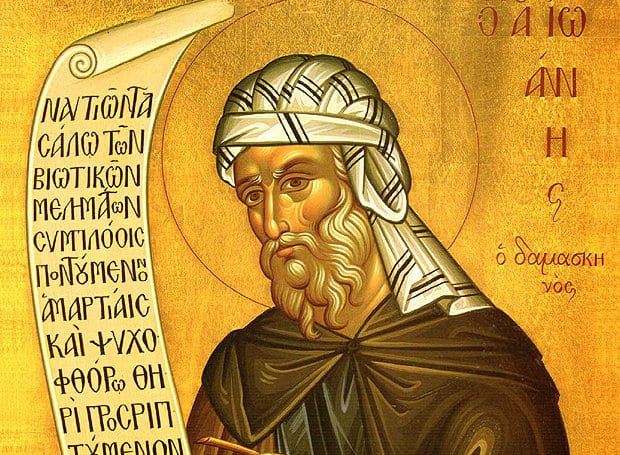
Πρέπει να ξέρομε ότι ο άνθρωπος είναι διπλός, δηλαδή από σώμα και ψυχή, και έχει διπλές τις αισθήσεις και διπλές τις αρετές τους. Πέντε αισθήσεις έχει η ψυχή και πέντε το σώμα. Οι ψυχικές αισθήσεις είναι, νους, διάνοια, γνώμη, φαντασία και αίσθηση· οι σοφοί τις ονομάζουν και δυνάμεις. Οι σωματικές αισθήσεις είναι τούτες: όραση, όσφρηση, ακοή, γεύση και αφή. Γι΄ αυτό και διπλές είναι οι αρετές, διπλές και οι κακίες. Ώστε είναι αναγκαίο να γνωρίζει καθαρά ο κάθε άνθρωπος, πόσες είναι οι ψυχικές αρετές και πόσες οι σωματικές. Και ποια είναι τα ψυχικά πάθη και ποια τα σωματικά. Ψυχικές αρετές είναι εν πρώτοις οι τέσσερις γενικότατες αρετές, οι οποίες είναι, ανδρεία, φρόνηση, σωφροσύνη και δικαιοσύνη. Από αυτές γεννιούνται οι ψυχικές αρετές πίστη, ελπίδα, αγάπη, προσευχή, ταπείνωση, πραότητα, μακροθυμία, ανεξικακία, χρηστότητα, αοργησία, θεία γνώση, ευφροσύνη, απλότητα, αταραξία, ειλικρίνεια, η χωρίς έπαρση διάθεση, η χωρίς υπερηφάνεια, φθόνο, δόλο, η αφιλαργυρία, συμπάθεια, ελεημοσύνη, μεταδοτικότητα, αφοβία, αλυπία, κατάνυξη, σεμνότητα, ευλάβεια, επιθυμία των μελλόντων αγαθών, πόθος της βασιλείας του Θεού και επιθυμία της θείας υιοθεσίας.
Σωματικές αρετές, ή μάλλον εργαλεία των αρετών, που όταν γίνονται με γνώση κατά το θέλημα του Θεού και μακριά από κάθε υποκρισία και ανθρωπαρέσκεια, κάνουν τον άνθρωπο να προκόβει στην ταπείνωση και την απάθεια, είναι οι εξής: εγκράτεια, νηστεία, πείνα, δίψα, αγρυπνία, ολονύκτια στάση στην προσευχή, συνεχής γονυκλισία, αλουσία, χρήση ενός μόνο ενδύματος, ξηροφαγία, το να τρώει κανείς αραιά, να πίνει μόνο νερό, χαμαικοιτία, φτώχεια, ακτημοσύνη, αποφυγή περιποιήσεως, καλλωπισμού, αφιλαυτία, μόνωση, ησυχία, το να μη βγαίνει κανείς έξω, στέρηση, αυτάρκεια, σιωπή, το να κάνει κανείς εργόχειρο με τα χέρια του, και κάθε κακοπάθεια και σωματική άσκηση, και άλλα τέτοια, τα οποία, όταν είναι το σώμα εύρωστο και ενοχλείται από τα σαρκικά πάθη, είναι αναγκαιότατα και ωφελιμότατα. Όταν όμως το σώμα είναι εξασθενημένο και έχει, με τη βοήθεια του Θεού, νικήσει τα πάθη, δεν είναι τόσο αναγκαία, γιατί η αγία ταπείνωση και η ευχαριστία τα αναπληρώνουν όλα.
Τώρα πρέπει να κάνομε λόγο και για τις ψυχικές και σωματικές κακίες, δηλαδή τα πάθη. Ψυχικά πάθη είναι η λήθη, η ραθυμία και η άγνοια. Από τα τρία αυτά σκοτίζεται το μάτι της ψυχής, δηλαδή ο νους, και κυριεύεται από όλα τα πάθη, τα οποία είναι: ασέβεια, κακοδοξία, δηλαδή η κάθε αίρεση, βλασφημία, θυμός, οργή, πικρία, οξυθυμία, μισανθρωπία, μνησικακία, καταλαλιά, κατάκριση, λύπη χωρίς λόγο, φόβος, δειλία, φιλονικία, ζήλια, φθόνος, κενοδοξία, υπερηφάνεια, υποκρισία, ψεύδος, απιστία, πλεονεξία, φιλοϋλία, εμπαθής προσκόλληση σε κάτι, σχέση με γήινα πράγματα, ακηδία, μικροψυχία, αχαριστία, γογγυσμός, οίηση, έπαρση, σπουδαιοφάνεια, αλαζονεία, φιλαρχία, ανθρωπαρέσκεια, δολιότητα, αναίδεια, αναισθησία, κολακεία, υπουλότητα, ειρωνεία, διβουλία, συγκατάθεση σε αμαρτήματα του παθητικού μέρους της ψυχής και συνεχής μελέτη αυτών, περιπλάνηση των λογισμών, η μητέρα των κακών φιλαυτία και η ρίζα όλων των κακών φιλαργυρία, κακοήθεια και πονηρία.
Σωματικά πάθη είναι: γαστριμαργία, λαιμαργία, απόλαυση, μέθη, λαθροφαγία, ποικιλότροπη φιληδονία, πορνεία, μοιχεία, ασέλγεια, ακαθαρσία, αιμομιξία, παιδεραστία, κτηνοβασία, κακές επιθυμίες και όλα τα παρά φύση αισχρά πάθη· κλοπή, ιεροσυλία, ληστεία, φόνος, η κάθε σωματική άνεση και απόλαυση των θελημάτων της σάρκας, και μάλιστα όταν έχει υγεία το σώμα· μαντείες, μαγείες, οιωνισμοί, κλυδωνισμοί, αγάπη για στολίδια, κομπασμοί, νωθρότητες, καλλωπισμοί, φτιασιδώματα του προσώπου, η αξιοκατάκριτη αργία, φαντασιώσεις, τυχερά παιχνίδια, η εμπαθής παράχρηση των τερπνών του κόσμου, η φιλοσώματη ζωή που παχαίνει το νου και τον κάνει γήινο και κτηνώδη, και δεν τον αφήνει να σηκωθεί προς το Θεό και προς την εργασία των αρετών.
Ρίζες όλων αυτών των παθών και πρωταίτιες είναι η φιληδονία, η φιλοδοξία και η φιλαργυρία, από τις οποίες γεννιέται κάθε κακό. Δεν αμαρτάνει ποτέ ο άνθρωπος, αν πρωτύτερα δεν υπερισχύσουν και δεν τον κατακυριεύσουν οι δυνατοί γίγαντες που αναφέρει ο σοφότατος ασκητής Μάρκος, δηλαδή η λήθη, η ραθυμία και η άγνοια. Αυτές τις γεννά η ηδονή, η καλοπέραση και η αγάπη της δόξας των ανθρώπων και του περισπασμού. Πρωταίτια όλων αυτών και κακή μητέρα είναι, όπως προείπαμε, η φιλαυτία, δηλαδή η παράλογη αγάπη του σώματος και εμπαθής προσκόλληση σ΄ αυτό. Η διάχυση και η χαύνωση του νου με ευτραπελίες και αισχρολογίες προξενούν πολλά κακά και πολλές πτώσεις, όπως επίσης και η θρασύτητα και το γέλιο.
Πρέπει επίσης να γνωρίζομε ότι η εμπαθής φιληδονία είναι πολύμορφη και πολύτροπη, και είναι πολλές οι ηδονές που εξαπατούν την ψυχή, όταν δεν είναι στερεωμένη στο Θεό με νήψη και θείο φόβο, και δεν φροντίζει για την εργασία των αρετών με αγάπη προς το Χριστό. Γιατί είναι πάρα πολλές οι ηδονές που τραβούν προς τον εαυτό τους τα μάτια της ψυχής· είναι οι ηδονές των σωμάτων, των χρημάτων, της απολαύσεως, της δόξας, της ραθυμίας, της οργής, της εξουσίας, της φιλαργυρίας, της πλεονεξίας. Και φαίνονται όλες αυτές ότι έχουν λαμπερά πρόσωπα και αξιαγάπητα, ικανά να προσελκύσουν εκείνους που παθαίνονται για όλα αυτά και δεν έχουν σφοδρό έρωτα προς την αρετή και δεν υπομένουν τη σκληρότητά της. Κάθε σχέση με τα γήινα και η κάθε προσκόλληση σ΄ αυτά προξενεί ηδονή και ευχαρίστηση σ΄ αυτόν που την έχει, και αποδεικνύει ότι είναι ανώφελο και βλαβερό το επιθυμητικό μέρος της ψυχής όταν είναι εμπαθές, επειδή εξαιτίας του, εκείνος που αποστερείται κάτι που ποθεί, υποτάσσεται στο θυμό, στην οργή, στη λύπη και στη μνησικακία. Αν τώρα, μαζί με την εμπαθή προσκόλληση, επικρατήσει και κάποια έστω μικρή συνήθεια, αλίμονο! κάνει τότε εκείνον που κυριεύτηκε από αυτήν να ακολουθεί διαρκώς την παράλογη αυτή εμπαθή προσκόλληση αναίσθητα και χωρίς θεραπεία, με την ηδονή που είναι κρυμμένη μέσα σ΄ αυτήν.
Είναι πολυσχιδής η ηδονή της επιθυμίας, όπως προείπαμε· δεν αρκείται μόνο στην πορνεία και τις άλλες σωματικές απολαύσεις, αλλά ζητεί και τα λοιπά πάθη. Αφού, σωφροσύνη είναι όχι μόνον η αποχή από την πορνεία και τις σαρκικές ηδονές, αλλά να απέχει κανείς και από τις άλλες ηδονές. Γι΄ αυτό εκείνος που αγαπά τη φιλοχρηματία, τη φιλαργυρία και την πλεονεξία είναι ακόλαστος. Γιατί όπως ο ακόλαστος έχει έρωτα προς τα σώματα, έτσι και αυτός έχει έρωτα προς τα χρήματα. Ή μάλλον, αυτός είναι πιο ακόλαστος, αφού δεν έχει τόση βία από τη φύση να τον σπρώχνει σ΄ αυτά. Γιατί αμαθής ηνίοχος δεν είναι εκείνος πού δεν μπορεί να δαμάσει το άγριο και δυσάγωγο άλογο, αλλά εκείνος που δεν μπορεί να κρατήσει το ήμερο και ήσυχο άλογο. Και από παντού φαίνεται ότι είναι περιττή και όχι φυσική η επιθυμία των χρημάτων, γιατί δεν βιάζεται σ΄ αυτήν ο άνθρωπος από τη φύση, αλλά από την κακή του προαίρεση. Γι΄ αυτό και αμαρτάνει ασυγχώρητα εκείνος που νικιέται εκούσια από τη φιλοχρηματία. Ώστε πρέπει να γνωρίζομε καλά ότι η φιληδονία δεν έγκειται μόνον στην τρυφή και στην απόλαυση των σωμάτων, αλλά σε κάθε τρόπο και πράγμα που το αγαπά κανείς με πάθος και με την προαίρεση της ψυχής του. Και για να γνωρίζονται καθαρότερα τα πάθη που αφορούν στα τρία μέρη της ψυχής, προσθέτομε και τα παρακάτω με συντομία.
Η ψυχή διαιρείται σε τρία μέρη, το λογιστικό, το θυμικό και το επιθυμητικό.
Του λογιστικού αμαρτήματα είναι αυτά: απιστία, αίρεση, αφροσύνη, βλασφημία, αχαριστία, και οι συγκαταθέσεις των αμαρτημάτων, οι οποίες γίνονται από το παθητικό μέρος. Η ίαση και η θεραπεία αυτών των κακών είναι η αδίστακτη πίστη στο Θεό και τα αληθινά και χωρίς πλάνη ορθόδοξα δόγματα της ευσέβειας, η αδιάκοπη μελέτη των λόγων του Πνεύματος, η καθαρή και αδιάλειπτη προσευχή, και η ευχαριστία προς το Θεό.
Τα αμαρτήματα του θυμικού είναι τα εξής: η ασπλαχνία, το μίσος, η ασυμπάθεια, η μνησικακία, ο φθόνος, ο φόνος και η συνεχής αυτών και των παρομοίων μελέτη. Η ίαση και η θεραπεία τους είναι η φιλανθρωπία, η αγάπη, η πραότητα, η φιλαδελφία, η συμπάθεια, η ανεξικακία και η καλοσύνη.
Του επιθυμητικού τα αμαρτήματα είναι τα εξής: η γαστριμαργία, η λαιμαργία, η οινοποσία, η πορνεία, η μοιχεία, η ακαθαρσία, η ασέλγεια, η φιλοχρηματία, η επιθυμία της κενής δόξας και η επιθυμία χρυσού και πλούτου και σαρκικών ηδονών. Η ίαση και η θεραπεία αυτών είναι η νηστεία, η εγκράτεια, η κακοπάθεια, η ακτημοσύνη, το σκόρπισμα των χρημάτων στους φτωχούς, η επιθυμία των μελλόντων εκείνων αθάνατων αγαθών, ο πόθος της βασιλείας του Θεού και η επιθυμία της θείας υιοθεσίας.
Τώρα πρέπει να κάνομε λόγο για τη διάγνωση των εμπαθών λογισμών, από τους οποίους γίνεται η κάθε αμαρτία. Οκτώ είναι οι βασικοί λογισμοί της κακίας: της γαστριμαργίας, της πορνείας, της φιλαργυρίας, της οργής, της λύπης, της ακηδίας, της κενοδοξίας και της υπερηφάνειας. Το να μας παρενοχλούν ή να μη μας παρενοχλούν οι οκτώ αυτοί λογισμοί, αυτό δεν είναι στην εξουσία μας. Το να επιμένομε όμως σ΄ αυτούς ή να μην επιμένομε, να κινούμε τα πάθη ή να μην τα κινούμε, αυτό είναι στην εξουσία μας.
Στους λογισμούς αυτούς διακρίνομε τα εξής: προσβολή, συνδυασμό, πάλη, πάθος, συγκατάθεση (που πλησιάζει και μοιάζει με την πράξη), ενέργεια και αιχμαλωσία. Προσβολή είναι η απλή υπόμνηση του διαβόλου: «Κάνε τούτο ή εκείνο», όπως συνέβη στον Κύριο και Θεό μας: «Πες να γίνουν οι πέτρες αυτές ψωμιά». Αυτό, όπως είπαμε, δεν είναι στην εξουσία μας. Συνδυασμός είναι η παραδοχή του λογισμού που μας υποβάλλει ο εχθρός, και μ΄ ένα τρόπο, η μελέτη του πονηρού λογισμού και ηδονική συνομιλία με την προαίρεσή μας. Πάθος είναι η έξη που δημιουργείται από το συνδυασμό του λογισμού που υποβάλλει ο εχθρός, και η κατά κάποιο τρόπο συνεχής σχετική μελέτη και φαντασία. Πάλη είναι η αντίσταση στο λογισμό που γίνεται ή προς κατάργηση του πάθους που αυτός περιέχει – δηλαδή του εμπαθούς λογισμού – ή προς συγκατάθεση, καθώς λέει ο Απόστολος: «Η σάρκα επιθυμεί κατά του πνεύματος και το πνεύμα κατά της σάρκας, κι αυτά είναι αντίθετα μεταξύ τους». Αιχμαλωσία είναι η βίαιη και αθέλητη απαγωγή της καρδιάς που τυραννιέται από προηγούμενο εθισμό στην αμαρτία και μακρά συνήθεια. Συγκατάθεση είναι η συγκατάνευση στο πάθος που περιέχει ο λογισμός. Ενέργεια είναι η ίδια η πράξη του εμπαθούς λογισμού, στον οποίο συγκατατεθήκαμε. Εκείνος λοιπόν που αντιμετωπίζει απαθώς το πρώτο, δηλαδή την προσβολή, ή το διώχνει αμέσως με αντίρρηση και σταθερότητα, έκοψε με μια και όλα τα επόμενα.
Η κατάργηση των οκτώ παθών ας γίνεται με τον εξής τρόπο. Με την εγκράτεια καταργείται η γαστριμαργία· με τον θείο πόθο και την επιθυμία των μελλόντων αγαθών καταργείται η πορνεία· με τη συμπάθεια προς τους φτωχούς καταργείται η φιλαργυρία· με την αγάπη προς όλους και την καλοσύνη καταργείται η οργή· με την πνευματική χαρά καταργείται η κοσμική λύπη· με την υπομονή, την καρτερία και την ευχαριστία προς το Θεό καταργείται η ακηδία· με την κρυφή εργασία των αρετών και τη συνεχή προσευχή με συντριβή καρδιάς, καταργείται η κενοδοξία· με το να μην κρίνει κανείς τον άλλο ή να τον εξευτελίζει, όπως έκανε ο αλαζόνας Φαρισαίος, αλλά να νομίζει τον εαυτό του τελευταίο απ΄ όλους, καταργείται η υπερηφάνεια. Έτσι λοιπόν, αφού ελευθερωθεί ο νους από τα παραπάνω πάθη και ανυψωθεί στο Θεό, ζει από εδώ τη μακάρια ζωή και δέχεται τον αρραβώνα του Αγίου Πνεύματος. Και όταν φύγει από εδώ, έχοντας απάθεια και αληθινή γνώση, στέκεται μπροστά στο φως της Αγίας Τριάδας, και καταφωτίζεται μαζί με τους αγίους αγγέλους στους απέραντους αιώνες.
Η ψυχή λοιπόν, όπως προαναφέρθηκε, έχει τρία μέρη· αυτά είναι: λογισμός, θυμός και επιθυμία. Όταν στο θυμικό μέρος υπάρχει αγάπη και φιλανθρωπία, και στην επιθυμία καθαρότητα και σωφροσύνη, τότε ο λογισμός είναι φωτισμένος· όταν όμως στο θυμικό μέρος υπάρχει μισανθρωπία και στο επιθυμητικό υπάρχει ακολασία, τότε ο λογισμός είναι σκοτισμένος. Ο λογισμός λοιπόν τότε υγιαίνει και σωφρονεί και φωτίζεται, όταν έχει τα πάθη υποταγμένα και θεωρεί πνευματικά τους λόγους των κτισμάτων του Θεού και ανυψώνεται προς την μακάρια και Αγία Τριάδα. Ο θυμός τότε κινείται κατά φύση, όταν αγαπά όλους τους ανθρώπους και δεν έχει εναντίον κανενός λύπη ή μνησικακία. Η δε επιθυμία, όταν με την ταπεινοφροσύνη, την εγκράτεια και την ακτημοσύνη νεκρώσει τα πάθη, δηλαδή την ηδονή της σάρκας και τον πόθο των χρημάτων και της πρόσκαιρης δόξας, και στραφεί προς το θείο και αθάνατο έρωτα. Γιατί η επιθυμία κινείται προς τρία πράγματα: είτε προς τη σαρκική ηδονή, είτε προς τη μάταιη δόξα, ή προς απόκτηση χρημάτων. Και για την παράλογη αυτή έφεση καταφρονεί το Θεό και τις άγιες εντολές Του, λησμονεί τη θεϊκή ευγένεια, γίνεται θηρίο εναντίον του πλησίον, σκοτίζει το λογισμό και δεν αφήνει να στραφεί και να δει την αλήθεια. Ενώ εκείνος που απόκτησε ανώτερο φρόνημα, όπως προείπαμε, απολαμβάνει από εδώ τη βασιλεία των ουρανών και ζει μακάρια ζωή αναμένοντας τη μακαριότητα που προορίζεται για όσους αγαπούν το Θεό. Αυτής είθε ν΄ αξιωθούμε κι εμείς με τη χάρη του Κυρίου μας Ιησού Χριστού. Αμήν.
Πρέπει να γνωρίζομε και αυτό· ότι δεν μπορούμε να φτάσομε στο μέτρο κάποιας αρετής, παρά με κοπιαστική φιλοπονία για την απόκτησή της και προσπαθώντας με όση δύναμη έχουμε σ΄ όλη μας τη ζωή, όπως λόγου χάρη για την ελεημοσύνη, την εγκράτεια, την προσευχή, την αγάπη, ή κάποια από τις γενικές αρετές. Από αυτές μερικώς ο καθένας ασκεί κάποια αρετή· λ.χ. ασκεί κανείς πότε-πότε την ελεημοσύνη, αλλά επειδή την ασκεί λίγο, δεν μπορούμε να τον χαρακτηρίσομε ελεήμονα, κι ακόμη περισσότερο όταν δεν το κάνει αυτό καλά και θεάρεστα. Γιατί το καλό δεν είναι καλό όταν δε γίνεται καλά. Αλλά καλό είναι πράγματι όταν δεν απολαμβάνει εδώ το μισθό του από οποιαδήποτε αιτία, π.χ. από ανθρωπαρέσκεια λόγω καλής φήμης, ή επιδίωξη δόξας, ή από πλεονεξία και αδικία. Επειδή ο Θεός δε ζητεί εκείνα που γίνονται και νομίζονται καλά, αλλά εξετάζει το σκοπό για τον οποίο γίνονται. Όπως λένε και οι θεοφόροι Πατέρες, όταν ο νους λησμονήσει το σκοπό της ευσέβειας, τότε και το έργο που είναι φανερά ενάρετο, γίνεται ανώφελο· και εκείνα που γίνονται χωρίς διάκριση και σκοπό, όχι μόνο δεν ωφελούν και αν ακόμη είναι καλά, αλλά βλάπτουν. Το αντίθετο συμβαίνει μ΄ εκείνα που νομίζονται κακά, γίνονται όμως με θεοσεβή σκοπό· όπως εκείνος που μπήκε στο πορνείο και τράβηξε από εκεί την πόρνη. Από αυτό γίνεται φανερό ότι δεν είναι ελεήμων εκείνος που έκανε λίγες φορές την ελεημοσύνη, ούτε είναι εγκρατής εκείνος που εγκρατεύθηκε λίγο, αλλά εκείνος που πάρα πολλές φορές και σε όλη του τη ζωή εργάστηκε ολικά την αρετή με ασφαλή διάκριση. Γιατί η διάκριση είναι μεγαλύτερη απ΄ όλες τις αρετές, επειδή είναι βασίλισσα και αρετή των αρετών. Όπως πάλι και για τ΄ αντίθετα· δε λέμε πόρνο ή μέθυσο ή ψεύτη εκείνον που μια φορά γλίστρησε σ΄ ένα από αυτά, αλλά εκείνον που πέφτει συχνά σ΄ αυτά και μένει αδιόρθωτος. Κοντά σ΄ όσα είπαμε, πρέπει να γνωρίζομε και τούτο, που είναι και αναγκαιότατο σ΄ όλους εκείνους που έχουν ζήλο να κατορθώσουν την αρετή και επιμελούνται να αποφύγουν την κακία· ότι δηλαδή, όσο η ψυχή είναι ασυγκρίτως καλύτερη από το σώμα και σε πολλά και μέγιστα σημεία είναι σπουδαιότερη και πιο πολύτιμη, τόσο και οι ψυχικές αρετές – και μάλιστα εκείνες που μιμούνται το Θεό και έχουν το όνομά Του – είναι ανώτερες από τις σωματικές αρετές. Αντίθετα πρέπει να νοούμε για τις ψυχικές κακίες, ότι διαφέρουν από τα σωματικά πάθη και ως προς τις ενέργειές τους και ως προς την έκτιση των τιμωριών που επιβάλλονται σ΄ αυτές, αν και στους πολλούς, δεν ξέρω πως, αυτό τους διαφεύγει. Γιατί τη μέθη, την πορνεία, τη μοιχεία, την κλοπή και τα παραπλήσια μ΄ αυτά, τα προσέχουν και τα αποφεύγουν, ή τα τιμωρούν, επειδή φαίνονται στους πολλούς βδελυρά. Απέναντι όμως στα ψυχικά πάθη, που είναι πολύ χειρότερα και βαρύτερα από αυτά και που οδηγούν στην κατάσταση των δαιμόνων και στην αιώνια κόλαση που τους περιμένει όσους τ΄ ακολουθούν χωρίς διόρθωση, μένουν αδιάφοροι. Εννοώ δηλαδή το φθόνο, τη μνησικακία, την πονηρία, την αναισθησία, τη φιλαργυρία, που ο Απόστολος την θεωρεί ρίζα όλων των κακών, και τα όμοιά τους.
Μιλήσαμε γι΄ αυτά με όλη την αμάθεια και την αφέλειά μας, κάνοντας μία ευσύνοπτη και σαφή έκθεση του λόγου περί αρετών και παθών, για να μπορεί κανείς εύκολα να διακρίνει και να εξακριβώνει τη διαίρεση και τη διαφορά τους με ακρίβεια και σαφήνεια. Γι΄ αυτό και μιλήσαμε για το καθένα με πολλούς τρόπους και από πολλές απόψεις, ώστε, αν είναι δυνατόν, καμιά πλευρά της αρετής ή της κακίας να μην αγνοείται· ακόμη για να επιδιώξομε με χαρά τις αρετές – και μάλιστα τις ψυχικές, με τις οποίες προσεγγίζομε στο Θεό – και για ν΄ αποφεύγομε τις κακίες με όλη μας τη δύναμη. Γιατί είναι αληθινά μακάριος εκείνος που ζητά την αρετή και την ασκεί και εξετάζει με επιμέλεια τι είναι αρετή, επειδή με αυτήν πλησιάζει το Θεό και ενώνεται νοερά μ΄ Αυτόν. Φρόνηση, ανδρεία, σοφία, αληθινή γνώση και πλούτος αναφαίρετος είναι κυρίως το ν΄ ανυψώνεται ο άνθρωπος με την πρακτική αρετή στη θεωρία του Δημιουργού.
Η αρετή λέγεται έτσι από το ρήμα «αιρείσθαι»· γιατί είναι αιρετή και θελητή, επειδή κάνομε αυτοπροαίρετα και θεληματικά το αγαθό, κι όχι χωρίς να θέλομε και αναγκαστικά. Η φρόνηση πάλι λέγεται έτσι, γιατί φέρνει στο νου τα ωφέλιμα.
Αν θέλεις, ας προσθέσομε στον αφελή αυτό λόγο, σαν χρυσή σφραγίδα, και λίγα περί του «κατ΄ εικόνα και ομοίωσιν» του πιο τιμημένου από όλα τα κτίσματα του Θεού, δηλαδή του ανθρώπου. Το νοερό και λογικό ζώο, ο άνθρωπος, μόνο απ΄ όλα τα κτίσματα είναι «κατ΄ εικόνα και ομοίωσιν» του Θεού. Κάθε άνθρωπος λέγεται «κατ΄ εικόνα Θεού» για το αξίωμα του νου και της ψυχής, δηλαδή το ακατάληπτο, το αόρατο, το αθάνατο, το αυτεξούσιο. Και ακόμη για την ικανότητα να άρχει, να τεκνοποιεί και να οικοδομεί. «Καθ΄ ομοίωσιν» λέγεται για την αρετή και τις πράξεις με τις οποίες μιμείται το Θεό και έχουν το όνομα του Θεού. Δηλαδή το να δείχνει φιλανθρωπία προς τους συνανθρώπους, να οικτείρει, να ελεεί και να αγαπά τους συνδούλους του, και να δείχνει στους άλλους κάθε ευσπλαχνία και συμπάθεια. «Να γίνεστε, λέει ο Χριστός και Θεός, σπλαχνικοί, όπως είναι σπλαχνικός και ο ουράνιος Πατέρας σας». Το «κατ΄ εικόνα» το έχει κάθε άνθρωπος, γιατί ο Θεός δεν ανακαλεί τα χαρίσματά Του. Το «καθ΄ ομοίωσιν» όμως το έχουν σπάνιοι και μόνον οι ενάρετοι και άγιοι, οι οποίοι μιμούνται – κατά το δυνατόν σε ανθρώπους – την αγαθότητα του Θεού. Είθε κι εμείς ν΄ αξιωθούμε την υπεράγαθη φιλανθρωπία του Θεού, αφού Του φανούμε ευάρεστοι με την αγαθοεργία και γίνομε μιμητές εκείνων που έχουν ευαρεστήσει από αιώνων το Χριστό. Γιατί σ΄ Αυτόν ανήκει το έλεος και σ΄ Αυτόν πρέπει κάθε δόξα, τιμή και προσκύνηση, μαζί με τον άναρχο Πατέρα Του, και το πανάγιο και αγαθό και ζωοποιό Πνεύμα Του, τώρα και πάντοτε και στους αιώνες των αιώνων.
Πηγή: Η άλλη όψη
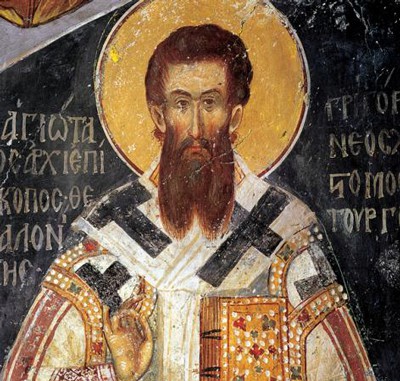
Σχόλια του νυν Μητροπολίτη Ναυπάκτου κ.Ιεροθέου στον ισχυρισμό του καθηγητή Δ.Κιτσίκη ότι ο άγιος Γρηγόριος Παλαμάς είχε εντυπωσιασθεί από τον Αλεβισμό, «που τόσο κοντά ευρισκόταν στην Ορθοδοξία», ώστε ειλικρινά πίστεψε πως σύντομα οι Τούρκοι θα γίνονταν Χριστιανοί Ορθόδοξοι...
Ο Καθηγητής της Ιστορίας του Πανεπιστήμιου της Οττάβας Δημήτριος Κιτσίκης σε άρθρο του στην «Παράδοση» αναφέρεται στο φαινόμενο του αλεβισμού, που παρουσιάζεται έντονα στην Τουρκία και δημιουργεί σ’ αυτήν προβλήματα. Μεταξύ των άλλων λέγεται ότι «ο όρος αλεβισμός» εμφανίστηκε στην Οθωμανική Αυτοκρατορία μονάχα στον 19ο αιώνα, για να χαρακτηρισθούν οι ετερόδοξοι. Συνεπώς πρωτύτερα σήμαινε απλώς, όπως και στο Ιράν, οπαδό του σιϊσμού. Πέρα από την ύπαρξη των Αλεβίδων και του όρου αλεβισμού, ο Καθηγητής παρουσιάζει και την φυσιογνωμία του αλεβισμού, γράφοντας: «Την ουσία όμως του Αλεβισμού, δηλαδή την σύνθεση σαμανισμού, σιϊσμού και ελληνοορθοδοξίας τη συναντάμε ήδη στο γενάρχη Οσμάν, η οποία μέσω των σουφιστικών ταγμάτων θα συνεχισθεί μέχρι τον 20ο αιώνα»1.
Από τις παρατηρήσεις του Καθηγητού φαίνεται ότι οι Αλεβίδες είναι ένα κράμα σαμανισμού, σιϊσμού και ελληνορθοδοξίας. Ιδίως αυτό το τελευταίο, αν πραγματικά συμβαίνει, είναι πολύ ενδιαφέρον σημείο για μας τους Ορθοδόξους. Ο Καθηγητής χρησιμοποιεί διάφορα παραδείγματα για να υποστηρίξη τις απόψεις του. Δεν έχω πρόθεση να τα αμφισβητήσω, δεδομένου μάλιστα ότι δεν είμαι επιστήμων ιστορικός, και φυσικά ούτε ποτέ ασχολήθηκα με το σοβαρό αυτό θέμα.
Οφείλω όμως να παρατηρήσω ότι κλονίστηκα σημαντικά από την χρησιμοποίηση ενός παραδείγματος από την ζωή του Αγίου Γρηγορίου του Παλαμά, που συνέβη κατά τον χρόνο της αιχμαλωσίας στους Τούρκους. Οι προσωπικές μου παρατηρήσεις από την ανάγνωση των επιστολών του Αγίου Γρηγορίου τού Παλαμά προς την Εκκλησία της Θεσσαλονίκης, στις οποίες αναφέρονται οι θεολογικές συζητήσεις, που είχε ο άγιος Γρηγόριος με τον εγγονό του Ορχάν, τους Χιόνες και άλλους Μωαμεθανούς, καταλήγουν σε διαφορετικά συμπεράσματα από αυτά του Καθηγητού. Θα ήθελα να παραθέσω τα όσα λέγονται από τον Κιτσίκη και στην συνέχεια να εκθέσω τα δικά μου σχόλια και τις προσωπικές μου παρατηρήσεις.
Γράφει ο Καθηγητής: «Χαρακτηριστικό παράδειγμα είναι ο ελληνοτουρκικός διάλογος του Αγίου Γρηγορίου Παλαμά το 1354 στην αυλή του Ορχάν με τον γιό τού Οθωμανού ηγεμόνα Ισμαήλ και τους λεγομένους Χίονες, παρουσία του Έλληνα γιατρού του Ορχάν, του Ταρωνίτη. Άσχετα από το ποια ακριβώς δοξασία είχαν οι Χίονες, γεγονός είναι πως ο Ορχάν τους χρησιμοποιούσε για θεολόγους του αντί για ουλεμάδες τού σουνιτικού Ισλάμ και ότι αυτοί οι Χίονες πρέσβευαν κάποια μορφή συγκρητισμού. Γεγονός επίσης είναι πως ο Παλαμάς τόσο πολύ εντυπωσιάσθηκε από το κατ’ ουσίαν Αλεβισμό της ηγεμονίας τού Ορχάν, ώστε ευρισκόμενος στη Νίκαια και συζητώντας στον δρόμο θρησκευτικά θέματα με τους περαστικούς έγραψε το περίφημο: «Εις δε τις εκείνων είπεν ως εσταί ποτε ότε συμφωνήσομεν αλλήλοις· και εγώ συνεθέμην και επευξάμην τάχιον ήκειν τον καιρόν εκείνον». Με άλλα λόγια ο Παλαμάς είχε σε τέτοιο σημείο εντυπωσιασθεί από τον Αλεβισμό, που τόσο κοντά ευρισκόταν στην Ορθοδοξία, ώστε ειλικρινά πίστεψε πως σύντομα οι Τούρκοι θα γίνονταν Χριστιανοί Ορθόδοξοι»2.
Στο κείμενο αυτό έχουν εισχωρήσει πολλές παρερμηνείες, τις οποίες θα προσπαθήσω να παρουσιάσω. Αυτό θα καταδείξη ότι στα ιστορικά θέματα χρειάζεται προσεκτική μελέτη των πηγών και ποτέ δεν πρέπει να χρησιμοποιούμε διάφορα ιστορικά γεγονότα για να υποστηρίξουμε μια προσωπική μας άποψη, δηλαδή δεν πρέπει να στοχαζόμαστε πάνω σε ιστορικά γεγονότα.
Δεν επιθυμώ να ενδιατρίψω στην προέλευση τού ονόματος τους, την φυσιογνωμία τους κ.λ.π., γιατί ο αναγνώστης μπορεί να βρη εκτενή ανάλυση στην κατατοπιστική εισαγωγή του Παναγιώτου Χρήστου12. Μόνον θα ήθελα να παραθέσω το συμπέρασμα τού ανωτέρω Καθηγητού: «Οι Χιόναι είχον βασικώς αποστή της χριστιανικής πίστεως, αλλ’ ήθελον να έχουν την συνείδησίν των ήσυχον ότι διετήρουν μέρος αυτής κρυφίως ως κρυπτοχριστιανοί — και τούτο ήθελον να αποκρύψουν από τον Ορχάν —, ενώ ηδύναντο να εμφανίζωνται και ως Τούρκοι και ως Ιουδαίοι. Ήσαν μία συγκρητιστική ομάς, διαμορφωθείσα εκ των στυγνών συνθηκών της τουρκικής εισβολής εις την Μικράν Ασίαν»13. Είναι πιθανόν ο Ορχάν να χρησιμοποίησε «επίλεκτα μέλη της οικογενείας αυτής εις το υπανάπτυκτον εκπαιδευτικόν σύστημά του»14.
Η συζήτηση τού Αγίου Γρηγορίου με τους Χιόνες δεν έγινε σε κλίμα ευχάριστο. Πολλές φορές στον διασωθέντα διάλογο λέγεται ότι οι Τούρκοι και οι Χιόνες διέκοπταν τον άγιο Γρηγόριο θορυβούντες15. Μάλιστα δε στο τέλος της διαλέξεως ένας από τους Χιόνες στράφηκε εναντίον τού Αγίου Γρηγορίου και τον εράπισε. «Εις δε των Χιόνων προσκαρτερήσας ύβρισε τον μέγαν τού Θεού αρχιερέα αισχρώς και ορμήσας επάνω αυτού έδωκεν αυτώ πληγάς κατά κόρρης»16. Βέβαια, οι άλλοι παριστάμενοι Τούρκοι τον κατηγόρησαν και τον επετίμησαν, αλλά το γεγονός είναι ότι η συζήτηση δεν έγινε σε ομαλές συνθήκες, όπως θα έπρεπε να γινόταν αν υπήρχε ευνοϊκότητα σχέσεων μεταξύ των Τούρκων και τού Αγίου Γρηγορίου τού Παλαμά.
Η ίδια ατμόσφαιρα σχεδόν επικράτησε και στην τρίτη θεολογική συζήτηση που είχε ο άγιος Γρηγόριος με τους Τούρκους κατά τον χρόνο της εξορίας του. Στο σημείο αυτό θα δούμε την μεγαλύτερη απομάκρυνση τού Κιτσίκη από το κείμενο τού Αγίου.
Ο Κιτσίκης λέγει ότι ο άγιος Γρηγόριος συζητούσε «στο δρόμο θρησκευτικά θέματα με τους περαστικούς»17. Γεγονός πάντως είναι ότι η συζήτηση διεξήχθη μεταξύ τού Αγίου Γρηγορίου και τού τασιμάνη, που ήταν υπεύθυνος για την λατρεία των Τούρκων, ύστερα από την κηδεία ενός Μουσουλμάνου, παρουσία βεβαίως μερικών Τούρκων και Χριστιανών. Και η συζήτηση περιστράφηκε στην διαφορά μεταξύ τού Μωάμεθ και τού Χριστού, θέμα που ήταν το κεντρικό σημείο κατά την διάρκεια των θεολογικών συζητήσεων.
Πράγματι, κατά την διάρκεια της συζητήσεως αυτής ένας από τους παρισταμένους Τούρκους είπε: «έσται ποτέ ότε συμφωνήσομεν», δηλαδή θα έλθη καιρός που θα συμφωνήσουμε μεταξύ μας. Και τότε ο άγιος Γρηγόριος απήντησε: «Και εγώ συνεθέμην και επευξάμην τάχιον ήκειν τον καιρόν εκείνον», δηλαδή συμφώνησε και ευχήθηκε να έλθη το ταχύτερο ο καιρός εκείνος18. Το πρόβλημα όμως είναι ότι ο Κιτσίκης το ερμηνεύει λανθασμένα και δίδει την εντύπωση ότι ο άγιος Γρηγόριος ο Παλαμάς εντυπωσιάσθηκε από τον Αλεβισμό «που τόσο κοντά ευρισκόταν στην Ορθοδοξία, ώστε ειλικρινά πίστεψε πως σύντομα οι Τούρκοι θα γίνονταν Χριστιανοί Ορθόδοξοι». Από όσα όμως προηγήθηκαν της φράσεως αυτής και από την ερμηνεία που έδωσε ο άγιος Γρηγόριος σ' αυτήν αποκλείεται να εντυπωσιάσθηκε και να πίστευσε ε ι λ ι κ ρ ι ν ά ότι γρήγορα οι Τούρκοι θα γίνονταν Ορθόδοξοι Χριστιανοί. Και εξηγούμαι περισσότερο.
Ο άγιος Γρηγόριος ο Παλαμάς με τρόπο έξυπνο και ομολογιακό, κατά την διάρκεια της συζητήσεως, έστρεψε πολύ γρήγορα τον λόγο στην διαφορά μεταξύ του Μωάμεθ και τού Χριστού και τόνισε την υπεροχή του Χριστού έναντι του Μωάμεθ. Αναφέρθηκε στην διαγωγή του Μωάμεθ και των Μωαμεθανών, που κυρίευσαν τα μέρη εκείνα με πόλεμο και μάχαιρα, με λεηλασίες, ανδραποδισμούς και φόνους, με ενέργειες, δηλαδή, που δεν προέρχονταν από τον αγαθό Θεό, αλλά με θέλημα του ανθρωποκτόνου διαβόλου, ενώ αντίθετα ο Χριστιανισμός απλώθηκε στον κόσμο με την αγάπη και την εγκράτεια κ.λ.π.19. Στο σημείο αυτό φάνηκε η τεράστια διαφορά μεταξύ των Χριστιανών και των Τούρκων.
Η παρατήρηση αυτή του Αγίου Γρηγορίου εξηρέθισε τους παρισταμένους Τούρκους - Μουσουλμάνους και κινήθηκαν «προς οργήν». Τότε ακριβώς οι παριστάμενοι Χριστιανοί έκαναν νοήματα στον άγιο Γρηγόριο «παρείναι τον λόγον», δηλαδή να περατώση τον λόγο. Τότε ο άγιος Γρηγόριος, κάνοντας ιλαρό τον λόγο του και υπομειδιάσας, είπε: «Ει γε κατά τους λόγους συνεφωνούμεν ενός αν ήμεν και δόγματος», δηλαδή αν συμφωνούσαμε στην διδασκαλία τότε θα ανήκαμε σε ένα δόγμα. Με τον λόγο αυτόν ο άγιος Γρηγόριος ήθελε να κάνη τον λόγο του ιλαρότερο, να μη φθάσουν στα άκρα, και φυσικά έδειχνε και την μεγάλη διαφορά που υπήρχε μεταξύ τους.
Γι' αυτό σημειώνει ο ίδιος: «Αλλ' ο νοών νοείτω των ειρημένων την δύναμιν»20.
Αφού χαμήλωσαν οι τόνοι της συζητήσεως, κάποιος από τους παρισταμένους είπε ότι θα έλθη καιρός που θα συμφωνήσουν. Τότε ακριβώς ο άγιος Γρηγόριος Παλαμάς λέγει ότι συμφώνησε και ευχήθηκε να έλθη το ταχύτερο. Πρέπει να δούμε τον λόγο αυτόν στην όλη ατμόσφαιρα που προηγήθηκε και όχι στον ενθουσιασμό τού Αγίου Γρηγορίου τού Παλαμά για τον Αλεβισμό «που τόσο κοντά ευρισκόταν στην Ορθοδοξία». Και φυσικά αυτό φαίνεται καθαρά και από την ερμηνεία που έδωσε ο ίδιος ο άγιος Γρηγόριος της ιδικής του φράσεως.
Γράφει ότι συμφώνησε σ’ αυτόν τον λόγο ενθυμηθείς τον λόγο τού Αποστόλου Παύλου, «τω ονόματι Ιησού Χριστού παν γόνυ κάμψει και πάσα γλώσσα εξομολογήσηται ότι Κύριος Ιησούς Χριστός εις δόξαν Θεού πατρός». Και μάλιστα επεξηγεί στο ποίμνιό του ότι αυτό θα γίνη κατά την Δευτέρα Παρουσία τού Χριστού: «τούτο ο’ έσται πάντως εν τη δευτέρα παρουσία τού Κυρίου Ημών Ιησού Χριστού21».
Μελετώντας το κείμενο αυτό του Αγίου Γρηγορίου τού Παλαμά δεν μπόρεσα πουθενά να δω, όσο καλή διάθεση και αν είχα, ότι ο άγιος εντυπωσιάσθηκε από τον Αλεβισμό, και ότι «ειλικρινά πίστεψε πως σύντομα οι Τούρκοι θα γίνονταν Χριστιανοί Ορθόδοξοι», όπως λέγει ο Κιτσίκης. Αντίθετα είδα την φράση τού Αγίου Γρηγορίου τού Παλαμά ως μια διπλωματική ενέργεια για να τελειώση καλά η συζήτηση, κατά την οποία μίλησε με παρρησία και θα έλεγα προκλητικά εναντίον τού Μωάμεθ, προξενώντας οργή στους παρισταμένους Τούρκους.
Από τις τρεις αυτές θεολογικές συζητήσεις φαίνεται ότι το κεντρικό θέμα τους ήταν η τεράστια διαφορά μεταξύ τού Χριστού και τού Μωάμεθ. Ο άγιος Γρηγόριος πάντοτε επανέφερε την συζήτηση σ’ αυτό το σημείο. Ξεκινούσε από το ότι το Κοράνιο πίστευε στον Χριστό ως λόγο τού Θεού. Η αντίθεσή του ήταν ότι οι Χριστιανοί δεν μπορούν να δεχθούν τον Μωάμεθ ως Προφήτη. Φυσικά και οι Τούρκοι ζητούσαν από τους Χριστιανούς να δεχθούν τον Μωάμεθ ως Προφήτη, αφού και το Κοράνιό τους δέχεται τον Χριστό. Συνεπώς, το ότι οι συζητούντες με τον άγιο Γρηγόριο τον Παλαμά Τούρκοι φαίνονταν ότι αναγνώριζαν τον Χριστό ως λόγο του Θεού, αυτό δεν το έκαναν γιατί ήταν φιλικά διακείμενοι προς τους Χριστιανούς, αλλά γιατί το γράφει το Κοράνιο.
Βέβαια, πρέπει να πούμε ότι την εποχή εκείνη οι Μουσουλμάνοι δέχονταν διάφορες επιρροές τόσο από τον νεοπλατωνισμό όσο και από τον χριστιανικό ασκητισμό. Χαρακτηριστικό παράδειγμα είναι ο Τζαλαλουντίν Ρουμί22. Αυτός ο επηρεασμός και συγκρητισμός, που είναι φαινόμενο που παρουσιάζεται σε κάθε εποχή και σε οπαδούς διαφόρων ομολογιών και θρησκειών, είναι ένα καθολικό φαινόμενο. Φαίνεται όμως από το περιστατικό του Αγίου Γρηγορίου του Παλαμά ότι δεν πρόκειται για κάποιο πλησίασμα των Μουσουλμάνων προς τον Χριστιανισμό, αλλά μάλλον το αντίθετο, δηλαδή φανερώνεται η επιθετική τους διάθεση. Και το ότι μερικοί εξαναγκάζονταν να προσχωρήσουν στον Μουσουλμανισμό, όπως φαίνεται εν μέρει και στους Χιόνας, δείχνει τις φονικές και εχθρικές διαθέσεις των Τούρκων, και όχι τόσο την φιλία τους.
Σε πολλά σημεία των επιστολών που απέστειλε ο άγιος Γρηγόριος ο Παλαμάς προς το ποίμνιο της Θεσσαλονίκης, συναντούμε πολύ βαρεία επίθετα για τους Τούρκους, οι οποίοι υποτίθεται, κατά τον Κιτσίκη, είχαν ενθουσιάσει τον άγιο Γρηγόριο. Τους Ονομάζει βαρβάρους, και μάλιστα «τοις πάντων βαρβάρων βαρβαρωτάτοις»23. Οι Τούρκοι αποτελούν «το δυσεβές και θεομισές και παμμίαρον τούτο γένος», που ο Θεός παρέδωσε σε αδόκιμο νου και πάθη ατιμίας, «ώστε βιούν αισχρώς και απανθρώπως και θεομισώς»24. Αισθάνεται ο άγιος Γρηγόριος ότι οδηγείται από χέρια άνομα: «...αρπαγέντες οίον χερσίν άνομων εκείθεν»25. Γράφει ότι οι Τούρκοι χρησιμοποιούσαν τους Χριστιανούς πολύ σκληρά. Η φράση «άγοντας, αγομένους όρων»26 δείχνει μια φρικτή πραγματικότητα. Όλα αυτά δεν θα τα έλεγε ο άγιος Γρηγόριος ο Παλαμάς εάν «είχε εντυπωσιασθεί από τον Αλεβισμό, που τόσο κοντά ευρισκόταν στην Ορθοδοξία», ούτε βέβαια ότι «ειλικρινά πίστεψε πως σύντομα οι Τούρκοι θα γίνονταν Χριστιανοί Ορθόδοξοι». Άλλωστε, μπορούμε να υποθέσουμε ότι διαψεύσθηκε τόσο γρήγορα ο μέγας αυτός Πατήρ της Εκκλησίας;
Βέβαια, το θέμα του αλεβισμού στην σύγχρονη εποχή πρέπει να μελετηθή. Δεν μπορώ να αμφισβητήσω τυχόν πραγματικά στοιχεία του Καθηγητή Κιτσίκη, ούτε να σταματήσω την προσπάθεια να βρεθούν ειρηνικές λύσεις για την περιοχή μας. Αλλά αυτό πρέπει να γίνεται με τις απαραίτητες προϋποθέσεις. Η μία, ότι δεν πρέπει να αλλοιώνουμε τα ιστορικά γεγονότα και να παραποιούμε τα κείμενα των Αγίων Πατέρων, για να γίνουν υποστηρίγματα των απόψεών μας. Η άλλη, ότι δεν πρέπει να μειώνουμε ή να περιφρονούμε την ορθόδοξη διδασκαλία.
Πραγματικά, δεν μπορεί ποτέ η Ορθόδοξη Εκκλησία να χρησιμοποιείται, και μάλιστα παραποιημένα, σε πολιτικές σκοπιμότητες.
Κάθε χώρα πρέπει να χρησιμοποιή τα κατάλληλα μέσα και τους καλύτερους τρόπους για να εξασκή την εξωτερική της πολιτική. Και στην εποχή μας το φαινόμενο τού αλεβισμού πρέπει να προσεχθή και να ερευνηθή με προσοχή και σοβαρότητα. Δεν θεωρώ όμως σωστό να εντάσσουμε την Ορθόδοξη Εκκλησία στην προσπάθεια αυτή. Γιατί τότε, εκτός των άλλων, δεν μπορούμε να κάνουμε ούτε ρωμαίικη πολιτική, ούτε φυσικά και επιστημονική έρευνα.
Αύγουστος 1993
1. Παράδοση Απρίλιος - Ιούνιος 1993. τεύχος 2. σελ. 142
2. Παράδοση, ένθ. ανωτ. σελ. 145
3. βλ. Γρηγορίου Παλαμά Συγγράμματα, τόμος Ο', επιμέλεια Παναγιώτου Χρήστου. σελ. 120-165
4. Παράδοση ένθ. ανωτ. σελ. 145
5. Γρηγορίου Παλαμά, Συγγράμματα, ένθ. ανωτ. σελ. 128
6. Liddel-Scott: Μέγα Λεξικόν της Ελληνικής Γλώσσης, εκδ. Σιδέρης, Αθήνα, τόμ. ΕΝ, σελ. 1416
7. Γρηγορίου Παλαμά Συγγράμματα, ένθ. ανωτ. σελ. 128, σημ. 1
8. ένθ. ανωτ. σελ. 128
9. ένθ. ανωτ. σελ. 130
10. ένθ. ανωτ. σελ. 130
11. Φιλοθέου Κοκκίνου, Βίος Γρηγορίου Παλαμά, ΕΠΕ σελ. 374
12. βλ. Γρηγορίου Παλαμά Συγγράμματα, ένθ. ανωτ. σελ. 68 και εξής.
13. ένθ. ανωτ. σελ. 62-63
14. ένθ. ανωτ. σελ. 63
15. ένθ. ανωτ. σελ. 158-159
16. ένθ. ανωτ. σελ. 165
17. Παράδοση ένθ. ανωτ. σελ. 145
18. Γρηνοοίου Παλαμα Συγγράματα. ένθ. ανωτ. σελ. 138
19. ένθ. ανωτ. σελ.σελ. 137
20. ένθ. ανωτ. σελ. 138
21. ένθ. ανωτ. σελ. 138
22. βλ. Αρχιμ. Ιεροθέου Βλάχου: Ρωμηοί σε Ανατολή και Δύση, έκδ. Ιεράς Μονής Γενεθλίου της Θεοτόκου (Πελαγίας). σελ. 113 και εξής.
23. Γρηγορίου Παλαμά Συγγράμματα, ένθ. ανωτ. σελ. 121
24. ένθ. ανωτ. σελ. 124-126
25. ένθ. ανωτ. σελ. 126
26. ένθ. ανωτ. σελ. 121
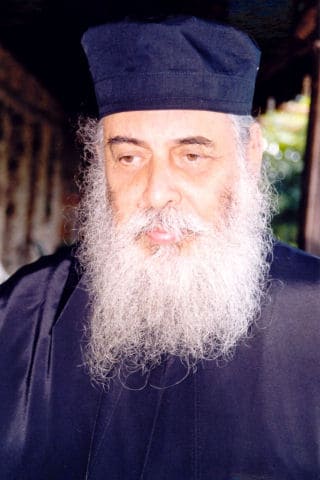
Στὸ κείμενο αὐτὸ ἐπισημαίνεται ὅτι ἡ Ὀρθόδοξος αὐτοσυνειδησία δὲν μᾶς ἐπιτρέπει νὰ παρακάμπτωμε τὸ γεγονὸς ὅτι ἡ Ὀρθοδοξία δὲν ἠμπορεῖ νὰ συναποτελῇ μαζὶ μὲ τὸν Δυτικὸ Χριστιανισμὸ μία ἑνιαία «χριστιανικὴ ταυτότητα», ἀλλὰ ἀντιθέτως μᾶς ὑποχρεώνει νὰ τονίσωμε ὅτι ἡ Ὀρθοδοξία εἶναι ἡ λησμονημένη ἀπὸ τὴν Εὐρώπη πρωτογενής της Πίστις, ἡ ὁποία πρέπει κάποτε νὰ ἀποτελέσῃ ἐκ νέου τὴν χριστιανική της ταυτότητα.
Ἡ Ἑνωμένη Εὐρώπη τοῦ 21ου αἰῶνος ἀναζητεῖ τὴν ταυτότητά της. Ἡ «εὐρωπαϊκὴ ταυτότης» δὲν ἀποτελοῦσε ἀντικείμενο σοβαροῦ προβληματισμοῦ, ἐφ᾿ ὅσον τὴν διεμόρφωναν μόνον οἰκονομικοὶ καὶ πολιτικοὶ παράγοντες. Ἀφ᾿ ὅτου ὅμως πολιτισμικοὶ καὶ ἰδίως θρησκευτικοὶ παράγοντες ἔπρεπε νὰ ληφθοῦν ὑπ᾿ ὄψιν κατὰ τὴν ἀναζήτησί της, ἀναπτύχθηκαν σοβαρὲς συζητήσεις, ἔντονες διαφωνίες καὶ ὀξεῖες διαμάχες γύρω ἀπὸ τὴν ἀναφορὰ ἢ μὴ τοῦ «Εὐρωπαϊκοῦ Συντάγματος» στὴν χριστιανικὴ ταυτότητα τῆς Εὐρώπης.
Τί σημαίνει ὅμως «χριστιανικὴ ταυτότης τῆς Εὐρώπης» γιὰ τοὺς Ὀρθοδόξους λαούς μας; Πόσο χριστιανικὴ εἶναι ἡ «χριστιανικὴ ταυτότης τῆς Εὐρώπης»;
Ὅσοι καλοπροαίρετα ἀγωνίζονται γιὰ τὴν ἐνίσχυσι τῆς χριστιανικῆς ταυτότητος τῆς Εὐρώπης ὁμιλοῦν συνήθως γι᾿ αὐτὴν ὡσὰν νὰ πρόκειται γιὰ ἕνα ἱστορικὸ δεδομένο ἢ ἕναν κώδικα χριστιανικῶν ἀρχῶν καὶ ἀξιῶν, στὶς ὁποῖες ἠμποροῦν νὰ συγκλίνουν οἱ χριστιανικοὶ λαοὶ μὲ τὴν βοήθεια τῶν οἰκουμενικῶν ἐπαφῶν καὶ διαχριστιανικῶν διαλόγων. Οἱ Χριστιανοὶ τῆς Εὐρώπης ἐπιδιώκουν νὰ τὴν ἐξασφαλίσουν θεσμικά, ἐπειδὴ φοβοῦνται τὸ ἐνδεχόμενο τοῦ θρησκευτικοῦ ἀποχρωματισμοῦ τῆς ἠπείρου των, τὴν ἀλλοίωσι τῆς χριστιανικῆς της ἰδιοπροσωπίας λόγω τῶν πληθυσμιακῶν μεταβολῶν (μετανάστευσις κ.λπ.) ἢ τὸν ἀποκλεισμὸ τῶν χριστιανικῶν «διεκκλησιαστικῶν» ὀργανισμῶν ἀπὸ τὰ κέντρα λήψεως ἀποφάσεων στὴν Εὐρώπη. Ἀκολουθώντας τὴν ἴδια λογική, καὶ οἱ προτάσεις ἐπισήμων Ὀρθοδόξων ἐκπροσώπων ἐπικεντρώνονται στὴν ἐνίσχυσι μιᾶς θεσμικῆς χριστιανικῆς παρουσίας στὴν Εὐρώπη.
Στὸ κείμενο αὐτὸ ἐπισημαίνεται ὅτι ἡ Ὀρθόδοξος αὐτοσυνειδησία δὲν μᾶς ἐπιτρέπει νὰ παρακάμπτωμε τὸ γεγονὸς ὅτι ἡ Ὀρθοδοξία δὲν ἠμπορεῖ νὰ συναποτελῇ μαζὶ μὲ τὸν Δυτικὸ Χριστιανισμὸ μία ἑνιαία «χριστιανικὴ ταυτότητα», ἀλλὰ ἀντιθέτως μᾶς ὑποχρεώνει νὰ τονίσωμε ὅτι ἡ Ὀρθοδοξία εἶναι ἡ λησμονημένη ἀπὸ τὴν Εὐρώπη πρωτογενής της Πίστις, ἡ ὁποία πρέπει κάποτε νὰ ἀποτελέσῃ ἐκ νέου τὴν χριστιανική της ταυτότητα.
* * *
Ζῶντες στὸ περιβάλλον τοῦ Ἁγίου Ὄρους καὶ στὴν πνευματικὴ ἀτμόσφαιρα ποὺ αὐτὸ δημιουργεῖ, ἀντιλαμβανόμεθα ὅτι ἡ Ὀρθόδοξος κληρονομιά μας δὲν πρέπει νὰ μετρῆται μὲ τὰ μέτρα τοῦ κόσμου τούτου. Τὰ τελευταῖα χρόνια γινόμεθα μάρτυρες τῆς εὐλαβείας καὶ τῆς βαθειᾶς πίστεως τῶν προσκυνητῶν τοῦ Ἁγίου Ὄρους, πολλοὶ ἐκ τῶν ὁποίων ἔρχονται μὲ πολὺ κόπο καὶ μὲ μεγάλα ἔξοδα ἀπὸ τὶς ὁμόδοξες χῶρες τῆς Βαλκανικῆς καὶ ἀπὸ τὴν Ρωσσία.
Στὴν συνείδησι ὅλων αὐτῶν τῶν εὐσεβῶν Ὀρθοδόξων Χριστιανῶν, ἀλλὰ καὶ ὅσων ἐκπροσωποῦν στὴν χώρα τους, ἡ Ὀρθοδοξία δὲν ἔχει συνήθως τὴν ἔννοια, ποὺ τῆς ἀποδίδουν ὅσοι τὴν βλέπουν ἢ τὴν ἀντιμετωπίζουν μὲ ἰδεολογικὰ ἢ κοινωνιολογικὰ κριτήρια, ὅσοι δηλαδὴ συνηθίζουν νὰ βλέπουν στὴν καθ᾿ ἡμᾶς Ἀνατολὴ ἀντιδυτικὰ «Ὀρθόδοξα» τόξα παράλληλα πρὸς τὰ μουσουλμανικά, ἢ θεωροῦν τὴν Ὀρθοδοξία ὡς ἐθνικιστικὴ δύναμι τῶν λαῶν ποὺ τὴν ἀσπάζονται. Ὅσο καὶ ἂν οἱ Ὀρθόδοξοι δημιουργοῦμε τέτοιες ἐντυπώσεις, λόγω τῶν προσωπικῶν μας ἀτελειῶν ἢ τῶν συλλογικῶν μας ἀστοχιῶν, ἔχουμε βαθειὰ ριζωμένη στὴν συνείδησί μας τὴν πεποίθησι ὅτι ἡ Ὀρθοδοξία εἶναι κάτι πολὺ πιὸ οὐσιαστικό, οὐράνιο, ἀκατάλυτο: εἶναι τὸ ἀνεκτίμητο δῶρο τοῦ ἁγίου Τριαδικοῦ Θεοῦ στὸν κόσμο, ἡ «ἅπαξ παραδοθεῖσα τοῖς ἁγίοις πίστις» (Ἰούδ. 3), τὴν ὁποία ἡ Ὀρθόδοξος Ἐκκλησία μας διασῴζει ἀκέραια, χωρὶς αἱρετικὲς παραχαράξεις, καὶ τὴν ὁποία μὲ πολλὲς θυσίες διαφυλάξαμε σὲ δύσκολους καιρούς, προκειμένου νὰ μὴ χάσουμε τὴν ἐλπίδα τῆς αἰωνίου ζωῆς.
Οἱ Ὀρθόδοξοι λαοὶ εἴμαστε ἠλεημένοι ἀπὸ τὸν ἅγιο Θεὸ νὰ φέρωμε τὴν σφραγῖδα τοῦ Ὀρθοδόξου ἁγίου Βαπτίσματος, νὰ κοινωνοῦμε τῆς ἁγίας Ὀρθοδόξου Εὐχαριστίας, νὰ ἀκολουθοῦμε μὲ ταπείνωσι τὴν δογματικὴ διδασκαλία τῶν ἁγίων ἑπτὰ Οἰκουμενικῶν Συνόδων ὡς μοναδικὴ ὁδὸ σωτηρίας, καὶ νὰ τηροῦμε «τὴν ἑνότητα τοῦ πνεύματος ἐν τῷ συνδέσμῳ τῆς εἰρήνης» (Ἐφ. δ´ 3). Φέρομε ὁμολογουμένως τὴν παρακαταθήκη τῆς Ὀρθοδόξου Πίστεως «ἐν ὀστρακίνοις σκεύεσι» (Β´ Κορ. δ´ 7), ἐν τούτοις ὅμως αὐτὴ συνιστᾷ Χάριτι Θεοῦ τὸν λόγο «τῆς ἐν ἡμῖν ἐλπίδος» (Α´ Πέτρ. γ´ 15).
Ἡ Ὀρθόδοξος Ἐκκλησία μας δὲν εἶναι ἁπλῶς κιβωτὸς τῆς ἐθνικῆς ἱστορικῆς μας κληρονομιᾶς. Πρωτίστως καὶ κυρίως εἶναι ἡ Μία Ἁγία Καθολικὴ καὶ Ἀποστολικὴ Ἐκκλησία.
Γιὰ νὰ μὴ χάσουν τὴν ἐλπίδα τῆς ἐν Χριστῷ αἰωνίου σωτηρίας, σὲ ἐποχὲς δύσκολες οἱ Ὀρθόδοξοι λαοὶ τῶν Βαλκανίων διετήρησαν τὴν Ὀρθόδοξο Πίστι τους μὲ τὴν θυσία χιλιάδων νεομαρτύρων, ἀντιστεκόμενοι τόσο στὸν ἐξισλαμισμὸ ὅσο καὶ στὸν ἐξουνιτισμό(1) . Γι᾿ αὐτὸ ἡ πρόσφατος, μετὰ τὴν κατάρρευσι τῶν ἀθεϊστικῶν καθεστώτων, ἀναζωπύρωσις τῆς Οὐνίας καὶ ἡ δραστηριότης τῶν νέο-προτεσταντικῶν Ὁμολογιῶν μεταξὺ Ὀρθοδόξων πληθυσμῶν ἀποτελοῦν σοβαρότατες προκλήσεις γιὰ τοὺς Ὀρθοδόξους. Καὶ ὡς τέτοιες πρέπει νὰ ἀντιμετωπίζωνται, ἐπειδὴ γιὰ μία ἀκόμη φορᾷ θέτουν ὑπὸ διακινδύνευσι τὴν σωτηρία ἁπλοϊκῶν ψυχῶν, «ὑπὲρ ὧν Χριστὸς ἀπέθανε» (πρβλ. Ρωμ. ιδ´ 15).
Στὶς δυτικὲς κοινωνίες ἐξάλλου, τὶς ἐκ παραδόσεως ρωμαιοκαθολικὲς καὶ προτεσταντικές, ὅπου ὑπάρχουν καὶ δραστηριοποιοῦνται Ὀρθόδοξες ἐνορίες, ἡ Ὀρθόδοξος παρουσία πρέπει νὰ εἶναι σεμνὴ μαρτυρία περὶ τοῦ αὐθεντικοῦ Χριστιανισμοῦ, τὸν ὁποῖον στερήθηκαν ἐπὶ αἰῶνες οἱ κοινωνίες αὐτές, λόγω τῶν παπικῶν καὶ προτεσταντικῶν παρεκκλίσεων ἀπὸ τὴν ἀποστολικὴ Πίστι. Κάθε φορὰ ποὺ ἡ νοσταλγικὴ ἀναζήτησις τῆς ἀνόθευτου χριστιανικῆς Πίστεως κορυφώνεται στὴν ἐπιστροφὴ ἑτεροδόξων Χριστιανῶν στὴν ἀγκάλη τῆς Μιᾶς Ἁγίας Καθολικῆς καὶ Ἀποστολικῆς Ἐκκλησίας, τῆς Ὀρθοδόξου, ἐκφράζεται ἡ ἱεραποστολικὴ φύσις τῆς Ἐκκλησίας. Ἐπιστρέφοντες οἱ ἑτερόδοξοι στὴν Ὀρθόδοξο Ἐκκλησία, δὲν ἐγκαταλείπουν μία ἐκκλησία γιὰ νὰ ἀσπασθοῦν μία ἄλλη, ὅπως λανθασμένα θεωρεῖται. Στὴν πραγματικότητα ἀφήνουν ἕνα ἀνθρωποκεντρικὸ ἐκκλησιαστικὸ σχῆμα καὶ ἐπανευρίσκουν τὴν μία καὶ μοναδικὴ Ἐκκλησία τοῦ Χριστοῦ, γίνονται μέλη τοῦ σώματος τοῦ Χριστοῦ καὶ ἐπαναπροσανατολίζονται στὴν πορεία τῆς θεώσεως.
Δυστυχῶς, ἀντίθετη κατεύθυνσι ἀκολουθεῖ ὁ συγκρητιστικὸς Οἰκουμενισμός, τὸν ὁποῖον ἐκφράζουν θεσμικὰ ὄργανα τῆς Οἰκουμενικῆς λεγομένης Κινήσεως καὶ φορεῖς τοῦ παποκεντρικοῦ Οἰκουμενισμοῦ. Ἐπειδὴ παραθεωροῦν τὴν Ὀρθόδοξο Ἐκκλησιολογία καὶ ἀκολουθοῦν τὴν προτεσταντικὴ «θεωρία τῶν κλάδων» ἢ τὴν νεωτέρα ρωμαιοκεντρικὴ θεωρία τῶν «ἀδελφῶν ἐκκλησιῶν», θεωροῦν ὅτι ἡ Ἀλήθεια τῆς Ἀποστολικῆς Πίστεως, ἢ μέρος αὐτῆς, διασῴζεται σὲ ὅλες τὶς Χριστιανικὲς ἐκκλησίες καὶ ὁμολογίες. Γι᾿ αὐτὸ κατευθύνουν τὶς προσπάθειές τους στὴν πραγματοποίησι μιᾶς ὁρατῆς ἑνότητος τῶν Χριστιανῶν, ἀνεξαρτήτως βαθυτέρας ἑνότητος στὴν Πίστι.
Ὑπὸ τὴν ἔννοια αὐτὴ ἡ οἰκουμενιστικὴ «θεολογία» ἐξισώνει τὸ Ὀρθόδοξο Βάπτισμα (τριπλῆ κατάδυσι) μὲ τὸ ρωμαιοκαθολικὸ ράντισμα, θεωρεῖ τὴν αἵρεσι τοῦ Filioque δογματικὰ ἰσοδύναμη μὲ τὴν Ὀρθόδοξο διδασκαλία περὶ τῆς ἐκπορεύσεως τοῦ Ἁγίου Πνεύματος ἐκ μόνον τοῦ Πατρός, μεθερμηνεύει τὸ πρωτεῖο ἐξουσίας τοῦ Πάπα τῆς Ρώμης ὡς πρωτεῖο διακονίας, ὀνομάζει θεολογούμενον τὴν Ὀρθόδοξο διδασκαλία περὶ διακρίσεως οὐσίας καὶ ἐνεργείας στὸν Θεὸ καὶ περὶ ἀκτίστου θείας Χάριτος, κ.ἄ.
Πρόκειται γιὰ ἕναν ἐπιπόλαιο οἰκουμενισμό, γιὰ τὸν ὁποῖο ἔγραφε εὔστοχα ὁ ἀείμνηστος π. Δημήτριος Στανιλοάε: «Δημιουργεῖται κάθε τόσο, ἀπὸ τὴν μεγάλη ἐπιθυμία γιὰ ἕνωση, ἕνας εὔκολος ἐνθουσιασμός, ποὺ πιστεύει πῶς μπορεῖ μὲ τὴν συναισθηματική του θερμότητα νὰ ρευστοποίηση τὴν πραγματικότητα καὶ νὰ τὴν ξαναπλάση χωρὶς δυσκολία. Δημιουργεῖται ἀκόμα καὶ μία διπλωματικὴ συμβιβαστικὴ νοοτροπία, ποὺ νομίζει πῶς μπορεῖ νὰ συμφιλίωση μὲ ἀμοιβαῖες ὑποχωρήσεις δογματικὲς θέσεις ἢ γενικώτερες καταστάσεις, ποὺ κρατοῦν τὶς ἐκκλησίες χωρισμένες. Οἱ δυὸ αὐτοὶ τρόποι, μὲ τοὺς ὁποίους ἀντιμετωπίζεται -ἢ παραθεωρεῖται- ἡ πραγματικότητα, φανερώνουν μία κάποια ἐλαστικότητα ἢ κάποια σχετικοποίηση τῆς ἀξίας ποὺ ἀποδίδεται σ᾿ ὡρισμένα ἄρθρα πίστεως τῶν ἐκκλησιῶν. Ἡ σχετικοποίηση αὐτὴ ἀντικαθρεφτίζει ἴσως τὴν πολὺ χαμηλὴ σημασία, ποὺ ὡρισμένες χριστιανικὲς ὁμάδες -στὸ σύνολό τους ἢ σ᾿ ὡρισμένους ἀπὸ τοὺς κύκλους τους- δίνουν σ᾿ αὐτὰ τὰ ἄρθρα τῆς πίστεως. Προτείνουν πάνω σ᾿ αὐτά, ἀπὸ ἐνθουσιασμὸ ἢ διπλωματικὴ νοοτροπία, συναλλαγὲς καὶ συμβιβασμούς, ἀκριβῶς γιατί δὲν ἔχουν τίποτα νὰ χάσουν μὲ αὐτὰ ποὺ προτείνουν. Οἱ συμβιβασμοὶ ὅμως αὐτοὶ παρουσιάζουν μεγάλο κίνδυνο γιὰ Ἐκκλησίες, ὅπου τὰ ἀντίστοιχα ἄρθρα ἔχουν σπουδαιότητα πρώτης γραμμῆς. Γιὰ τὶς Ἐκκλησίες αὐτὲς παρόμοιες προτάσεις συναλλαγῆς καὶ συμβιβασμοῦ ἰσοδυναμοῦν μὲ ἀπροκάλυπτες ἐπιθέσεις»(2) .
Παραλλήλως οἱ προτεσταντικὲς Ὁμολογίες, οἱ ὁποῖες ἔχουν φθάσει μέχρις ἀρνήσεως θεμελιωδῶν δογμάτων Πίστεως (τῆς ἱστορικότητος τῆς Ἀναστάσεως, τῆς ἀειπαρθενίας τῆς Θεοτόκου κ.ἄ.) καὶ ἀποδοχῆς ἀντιευαγγελικῶν ἠθῶν (γάμος ὁμοφυλοφίλων κ.λπ.), ἐξισώνονται στὰ πάνελ τοῦ Παγκοσμίου Συμβουλίου τῶν Ἐκκλησιῶν μὲ τὶς ἁγιώτατες Τοπικὲς Ὀρθόδοξες Ἐκκλησίες. Ἡ θεωρία τῆς «ἀπομυθεύσεως», ἡ «θεολογία» τοῦ «θανάτου τοῦ Θεοῦ», ἡ χειροτονία γυναικῶν σὲ ἱερατικοὺς βαθμούς, ἡ ἱερολογία γάμου ὁμοφυλοφίλων, ἀναμφίβολα δὲν ἀποτελοῦν στοιχεῖα τῆς χριστιανικῆς μας ταυτότητος.
Ὁ προτεσταντισμὸς περιῆλθε σὲ βαθύτατη κρίσι πίστεως. Ὁ Frank Schaeffer, ὁ ἐπώνυμος ἀμερικανὸς προτεστάντης ποὺ μετὰ ἀπὸ πολυετῆ καὶ σκληρὴ προσωπικὴ ἀναζήτησι ἔγινε Ὀρθόδοξος, στὸ βιβλίο τοῦ Dancing Alone, The Quest for Orthodox Faith in the Age of False Religion, Regina Orthodox Press, Salisburg, USA (σὲ ἑλληνικὴ μετάφρασι μὲ τίτλο: Ἀναζητώντας τὴν Ὀρθόδοξη Πίστη στὸν αἰῶνα τῶν ψεύτικων θρησκειῶν (2), ἔκδ. Μακρυγιάννη, Κοζάνη 2004), δίνει πολλὰ ἐνδιαφέροντα στοιχεῖα, ποὺ ἀποκαλύπτουν τὴν ἔκπτωσι τοῦ προτεσταντισμοῦ ἀπὸ τὴν Ἀλήθεια τῆς Μιᾶς Ἁγίας Καθολικῆς καὶ Ἀποστολικῆς Ἐκκλησίας.
Προέκτασι καὶ ἀναπόφευκτη συνέπεια τοῦ διαχριστιανικοῦ συγκρητισμοῦ ἀποτελεῖ ὁ διαθρησκειακὸς συγκρητισμός, ὁ ὁποῖος ἀναγνωρίζει δυνατότητα σωτηρίας σὲ ὅσους ἀνήκουν σὲ μία ἀπὸ τὶς μονοθεϊστικὲς θρησκεῖες. Ὀρθόδοξος ἐπίσκοπος ἔγραψε ὅτι «κατὰ βάθος, μία ἐκκλησία καὶ ἕνα τέμενος [τζαμί]... ἀποβλέπουν στὴν ἴδια πνευματικὴ καταξίωση τοῦ ἄνθρωπου»(3) . Ὁ διαθρησκειακὸς συγκρητισμὸς δὲν διστάζει ἀκόμη νὰ ἀναγνωρίση σωτηριώδεις ὁδοὺς σὲ ὅλες τὶς θρησκεῖες τοῦ κόσμου(4) . Πρὸ ὀλίγων ἐτῶν καθηγητὴς τοῦ Πανεπιστημίου Ἀθηνῶν ἔγραψε ὅτι ἠμπορεῖ νὰ ἀνάψη κερὶ μπροστὰ στὴν εἰκόνα τῆς Παναγίας, ὅπως καὶ μπροστὰ στὸ ἄγαλμα μιᾶς ἀπὸ τὶς θεὲς τοῦ Ἰνδουισμοῦ.
Ὀρθόδοξοι ἐπίσκοποι, κληρικοὶ καὶ θεολόγοι ἔχουν δυστυχῶς ἐπηρεασθῆ ἀπὸ τὴν συγκρητιστικὴ αὐτὴ νοοτροπία. Μὲ τὶς θεολογικές τους ἀπόψεις, τὶς ὁποῖες οἱ ἐκκοσμικευμένοι ἄρχοντες καὶ διανοούμενοι συνήθως ἀκούουν καὶ ἀναγνωρίζουν ὡς Ὀρθόδοξες, συντελοῦν ὥστε ἡ νοοτροπία αὐτὴ νὰ ὑπερβῇ τὰ στενὰ ὅρια τῶν προσωπικῶν τοὺς ἀντιλήψεων καὶ νὰ ἀποτελέση «γραμμή» μὲ στόχους καὶ ἐπιδιώξεις. Σὲ αὐτὴ τὴν προοπτικὴ ἡ ἀγάπη, χωρὶς ἀναφορὰ στὴν δογματικὴ ἀλήθεια, καθιερώνεται κριτήριο ἑνότητος τῶν Χριστιανῶν, ἐνῷ ἡ ἐμμονὴ στὶς παραδοσιακὲς Ὀρθόδοξες θεολογικὲς θέσεις ἀποδοκιμάζεται ὡς μισαλλοδοξία καὶ φονταμενταλισμός.
Ὅσον ἀφορᾷ τὸ πῶς ἡ οἰκουμενιστικὴ νοοτροπία οἰκοδομεῖ τὸν τύπο μιᾶς κατ᾿ ἐπίφασιν χριστιανικῆς ταυτότητος τῆς Εὐρώπης, εἶναι χαρακτηριστικὲς οἱ «δεσμεύσεις» τῶν ἐκπροσώπων τῶν χριστιανικῶν ἐκκλησιῶν ποὺ ὑπέγραψαν τὴν Οἰκουμενικὴ Χάρτα στὶς 22 Ἀπριλίου 2001(5) .
Ὅμως ἡ «χριστιανική» αὐτὴ ταυτότητα τῆς Εὐρώπης πολὺ ἀπέχει ἀπὸ τὴν ἀληθινὴ χριστιανικὴ ταυτότητα τῶν εὐρωπαϊκῶν λαῶν. Πρέπει νὰ τονισθῇ μὲ κάθε ἔμφασι ὅτι ἀδικεῖται ἡ Εὐρώπη, ὅταν τῆς προσάπτωμε μία ταυτότητα ποὺ δὲν εἶναι ἀληθινὰ χριστιανικὴ ἀλλὰ μόνο κατ᾿ ἐπίφασι. Ἕνας νοσηρός, ἕνας νοθευμένος, Χριστιανισμὸς δὲν εἶναι ὁ Χριστιανισμὸς τῶν κατακομβῶν τῆς Ρώμης, τοῦ ἁγίου Εἰρηναίου Λουγδούνου, τῶν Ὀρθοδόξων μοναχῶν τῆς Σκωτίας καὶ τῆς Ἰρλανδίας, γενικῶς ὁ Χριστιανισμὸς τῆς πρώτης χιλιετίας. Ἕνας νοθευμένος Χριστιανισμὸς δὲν ἠμπορεῖ νὰ προστατεύσῃ τὴν Εὐρώπη ἀπὸ τὴν εἰσβολὴ μὴ χριστιανικῶν ἀντιλήψεων καὶ ἠθῶν στὶς κοινωνίες της.
Εἶναι ἤδη γνωστὸ ὅτι οἱ πολλοὶ Εὐρωπαῖοι κουράσθηκαν ἀπὸ τὸν ξηρὸ ὀρθολογισμό, νοσταλγοῦν τὸν χαμένο μυστικισμό, καὶ γι᾿ αὐτὸ ἀσπάζονται τὸν μουσουλμανισμό, τὸν βουδισμὸ ἢ τὸν ἰνδουισμό, παραδίδονται στὸν ἐσωτερισμὸ ἢ ἐπιδιώκουν μεταφυσικὲς ἐμπειρίες σὲ νεοεποχιτικὰ κινήματα. Ἀναφέρεται ὅτι μόνο στὴν Ἰταλία λειτουργοῦν περὶ τὰ 500 μουσουλμανικὰ τεμένη, ἐνῷ στὴν Γαλλία τὸ 5% τοῦ πληθυσμοῦ εἶναι μουσουλμάνοι.
Ἡ Ὀρθόδοξος Ἐκκλησία κατέχει τὴν Ἀλήθεια. Στὸ κέντρο τῆς ἔχει τὸν Χριστό. Σὲ αὐτὴν ὅλα εἶναι θεανθρώπινα, γιατί ὅλα προσφερόμενα στὸν Θεάνθρωπο Κύριο χαριτώνονται ἀπὸ τὴν ἄκτιστο Χάρι τοῦ Ἁγίου Πνεύματος. Γι᾿ αὐτὸ ἠμπορεῖ νὰ ἀναπαύση τὶς ψυχὲς ποὺ ἀναζητοῦν καλοπροαίρετα τὴν ἐλευθερία τους ἀπὸ τὸν ἀσφυκτικὸ κλοιὸ τοῦ ὀρθολογισμοῦ, τοῦ ἐπιστημονισμοῦ, τοῦ ὑλισμοῦ, τοῦ ἰδεαλισμοῦ, τῆς τεχνοκρατίας. Γι᾿ αὐτὸ δὲν πρέπει νὰ συρθῇ ἡ Ὀρθοδοξία μέσα στὴν συγκρητιστικὴ χοάνη, δὲν πρέπει νὰ χαθῇ ἡ ἐλπὶς τοῦ σύμπαντος κόσμου.
Ὡς Ὀρθόδοξοι ποιμένες καὶ ὡς Ὀρθόδοξοι πιστοὶ ἔχουμε χρέος νὰ διαφυλάξωμε τὴν ἱερὰ παρακαταθήκη τῆς Ὀρθοδόξου Πίστεώς μας. Ὁ Ἀπόστολος τῶν Ἐθνῶν παραγγέλλει στοὺς πρεσβυτέρους τῆς Ἐφέσου καὶ στοὺς ποιμένας τῆς Ἐκκλησίας μέχρι σήμερα: «Προσέχετε οὖν ἑαυτοῖς καὶ παντὶ τῷ ποιμνίῳ, ἐν ᾧ ὑμᾶς τὸ Πνεῦμα τὸ Ἅγιον ἔθετο ἐπισκόπους, ποιμαίνειν τὴν Ἐκκλησίαν τοῦ Θεοῦ, ἣν περιεποιήσατο διὰ τοῦ ἰδίου αἵματος» (Πράξ. κ´ 28). Καὶ ὁ ἴδιος στὸν πιστὸ λαὸ τῆς Θεσσαλονίκης καὶ ὅλης τῆς Ἐκκλησίας: «ἀδελφοί, στήκετε καὶ κρατεῖτε τὰς παραδόσεις, ἂς ἐδιδάχθητε» (Β´ Θεσ. β´ 15).
Ἡ Γηραιὰ Ἤπειρος στὸν τομέα τῆς Πίστεως ἔχει ἀστοχήσει. Ἡ Νέα Ἐποχὴ ἀπειλεῖ ἀνοικτὰ πλέον τὶς εὐρωπαϊκὲς κοινωνίες μὲ ἀποχριστιανισμό. Δὲν εἶναι παράδοξο. Ἡ Εὐρώπη ἔστρεψε τὰ νῶτα στὸν Χριστό, κάποτε τὸν ἔδιωξε, ὅπως εὔστοχα παρατηροῦν ὁ Ντοστογιέφσκυ στὸν Μέγα Ἱεροεξεταστῆ(6) καὶ ὁ ἅγιος Νικόλαος ἐπίσκοπος Ζίτσης(7).
Ἡ Ὀρθόδοξος Ἐκκλησία ὀφείλει νὰ ἐκδηλώση τὸ χάρισμα καὶ τὴν ἀποστολή της, νὰ διακηρύξη στοὺς λαοὺς τῆς Εὐρώπης ὅτι, ἐὰν ὑπάρχη κάτι ποὺ μπορεῖ νὰ σώσῃ τὴν Εὐρώπη σὲ αὐτὴ τὴν κρίσιμη φάσι τῆς ἱστορίας της, εἶναι ἡ Ὀρθοδοξία. Ἂς μὴ στερήσουμε ἐμεῖς οἱ ἴδιοι ἀπὸ τὴν Ὀρθόδοξο Ἐκκλησία μας τὴν δυνατότητα νὰ δώση αὐτὸ τὸ σωτήριο μήνυμα στοὺς λαοὺς τῆς Εὐρώπης, ἐξισώνοντας τὴν Ὀρθόδοξο Πίστι μὲ τὴν αἵρεσι στὴν συγκεχυμένη προοπτικὴ καὶ τὸ ἀσαφὲς ὅραμα τοῦ συγκρητιστικοῦ Οἰκουμενισμοῦ. Μποροῦμε νὰ συντελέσουμε σὲ ἕναν ὑγιῆ, ἀπολύτως Ὀρθόδοξο, Οἰκουμενισμό, ἀποκαλύπτοντας στοὺς ἑτεροδόξους Χριστιανοὺς τὸ Μυστήριο τοῦ Θεανθρώπου καὶ τῆς Ἐκκλησίας Του, καὶ διακηρύσσοντας μαζὶ μὲ τὸν μακαριστὸ καὶ ὁμολογητὴ Γέροντα Ἰουστίνο Πόποβιτς: «Ἡ ἔξοδος ἀπὸ ὅλα τὰ ἀδιέξοδα, ἀνθρωπιστικά, οἰκουμενιστικά, παπιστικά, εἶναι ὁ ἱστορικὸς Θεάνθρωπος Κύριος Ἰησοῦς Χριστὸς καὶ τὸ ἱστορικὸν θεανθρώπινον οἰκοδόμημά Του, ἡ Ἐκκλησία, τῆς ὁποίας Αὐτὸς εἶναι ἡ αἰωνία Κεφαλὴ καὶ ἡ ὁποία εἶναι τὸ αἰώνιον Αὐτοῦ Σῶμα. Ἡ Ἀποστολική, Ἁγιοπατερική, Ἁγιοπαραδοσιακή, Ἁγιοσυνοδική, Καθολικὴ Ὀρθόδοξος Πίστις εἶναι τὸ φάρμακον τῆς ἀναστάσεως ἀπὸ ὅλας τὰς αἱρέσεις, ὅπως καὶ ἂν αὗται ὀνομάζωνται. Εἰς τελευταίαν ἀνάλυσιν, κάθε αἵρεσις εἶναι ἀπὸ τὸν ἄνθρωπον καὶ «κατ᾿ ἄνθρωπον»· κάθε μία ἀπὸ αὐτὰς τοποθετεῖ τὸν ἄνθρωπον εἰς τὴν θέσιν τοῦ Θεανθρώπου, ἀντικαθιστᾷ τὸν Θεάνθρωπον διὰ τοῦ ἀνθρώπου. Μὲ τοῦτο ἀρνεῖται καὶ ἀπορρίπτει τὴν Ἐκκλησίαν... Ἡ μόνη σωτηρία ἀπὸ αὐτὸ εἶναι ἡ ἀποστολικὴ θεανθρωπίνη πίστις, δηλαδὴ ὁλικὴ ἐπιστροφὴ εἰς τὴν θεανθρωπίνην ὁδὸν τῶν ἁγίων Ἀποστόλων καὶ τῶν ἁγίων Πατέρων. Τοῦτο δὲ σημαίνει ἐπιστροφὴν εἰς τὴν ἄμωμον ὀρθόδοξον πίστιν τῶν καὶ εἰς τὸν Θεάνθρωπον Χριστόν, εἰς τὴν κεχαριτωμένην θεανθρωπίνην ζωὴν τῶν ἐν τῇ Ἐκκλησίᾳ διὰ τοῦ Ἁγίου Πνεύματος, εἰς τὴν ἐν Χριστῷ ἐλευθερίαν τῶν... Ἄλλως, χωρὶς τὴν ἀποστολικὴν καὶ ἁγιοπατερικὴν ὁδόν, χωρὶς τὴν ἀποστολικὴν καὶ ἁγιοπατερικὴν ἀκολούθησιν ὄπισθεν τοῦ μόνου ἀληθινοῦ Θεοῦ εἰς ὅλους τοὺς κόσμους, καὶ τὴν λατρείαν τοῦ μόνου ἀληθινοῦ καὶ Ἀειζώου Θεοῦ, τοῦ Θεανθρώπου καὶ Σωτῆρος Χριστοῦ, εἶναι βέβαιον ὅτι ὁ ἄνθρωπος θὰ καταποντισθῇ εἰς τὴν νεκρὰν θάλασσαν τῆς εὐρωπαϊκῆς πολιτισμένης εἰδωλολατρίας καὶ ἀντὶ τοῦ Ζῶντος καὶ Ἀληθινοῦ Θεοῦ, θὰ λατρεύσῃ τὰ ψευδοείδωλα τοῦ αἰῶνος τούτου, εἰς τὰ ὁποῖα δὲν ὑπάρχει σωτηρία, οὔτε ἀνάστασις, οὔτε θέωσις διὰ τὸ θλιμμένον ὄν, τὸ ὀνομαζόμενον ἄνθρωπος(8).
(1) Ἀρχιμ. Γεωργίου Καψάνη, Καθηγουμένου Ἱερᾶς Μονῆς Ὁσίου Γρηγορίου Ἁγίου Ὄρους, «Ἡ Ἐκκλησιολογικὴ Αὐτοσυνειδησία τῶν Ὀρθοδόξων ἀπὸ τῆς Ἁλώσεως μέχρι τῶν ἀρχῶν τοῦ 20οῦ αἰῶνος», στὸν συλλογικὸ τόμο «ΕΙΚΟΣΙΠΕΝΤΑΕΤΗΡΙΚΟΝ» (ἀφιέρωμα στὸν Μητροπολίτη Νεαπόλεως καὶ Σταυρουπόλεως κ. Διονύσιο), Θεσσαλονίκη 1999, σ. 124. Βλ. ἐπίσης Ἀθανασίου Γιέφτιτς, ἐπισκόπου Βανάτου (νῦν πρώην Ζαχουμίου καὶ Ἐρζεγοβίνης), «Ἡ Οὐνία ἐναντίον τῆς Σερβικῆς Ὀρθοδοξίας», στὸν συλλογικὸ τόμο «Η ΟΥΝΙΑ ΧΘΕΣ ΚΑΙ ΣΗΜΕΡΑ», ἔκδ. Ἁρμός, Ἀθήναι 1992. Περὶ τῆς δραστηριότητος τῆς Οὐνίας στὴν Τρανσυλβανία, βλ. «30 Βίοι Ρουμάνων Ἁγίων», ἔκδ. Ὀρθοδόξου Κυψέλης, Θεσ/νίκη 1992, σ. 123.
(2) Dimitru Staniloae, «Γιὰ ἕνα Ὀρθόδοξο Οἰκουμενισμό», ἔκδ. Ἄθως, Πειραιεὺς 1976, σ. 19-20.
(3) «Ὀρθοδοξία καὶ Ἰσλάμ», ἔκδ. Ἱερᾶς Μονῆς Ὁσίου Γρηγορίου 1997, σ. 16.
(5) Βλ. Περιοδ. «Ἀπόστολος Βαρνάβας», Λευκωσία Κύπρου, τ.10/2001, σ. 411-423.
(6) Φ. Ντοστογιέβσκη, «Ἀδελφοὶ Καραμάζωφ», ἔκδ. Γκοβόστη, Ἀθήναι, σ. 99-121.
(7) Ἀρχιμ. Ἰουστίνου Πόποβιτς, «Ὀρθόδοξος Ἐκκλησία καὶ Οἰκουμενισμός», ἔκδ. Ὀρθόδοξος Κυψέλη, Θεσσαλονίκη 1974, σ. 238 καὶ 251-252.
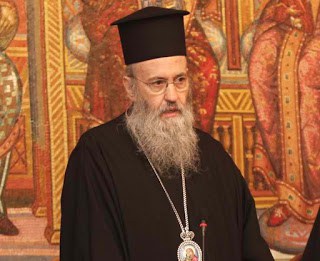
Ὁ ὅρος «ἐκκοσμίκευση» χρησιμοποιεῖται, ἰδιαιτέρως τόν τελευταῖο καιρό, πολύ συχνά, ἀλλά ὁ κάθε ἕνας χρησιμοποιεῖ τόν ὅρο αὐτό, γιά νά κατηγορήσει κάποια θεολογική ἔκφραση, ποὺ χρησιμοποιεῖται ἀπό κάποιον ἄλλον, μέ τόν ὅποιον διαφωνεῖ. Στήν οὐσία, χρησιμοποιεῖ τόν ὅρο αὐτό, γιά νά ἐξάρει τήν δική του θεολογία, τήν ὁποία συνήθως θεωρεῖ ὡς αὐθεντική. Βεβαίως, ὁ ὅρος «ἐκκοσμίκευση», γιά τήν θεολογία, χρησιμοποιεῖται γιά νά χαρακτηρίσει τήν δυτική θεολογία (σχολαστική καί προτεσταντική), ἡ ὁποία ἀποδεσμεύτηκε ἀπό τήν νηπτική – ἡσυχαστική παράδοση τῶν Πατέρων τῆς Ἐκκλησίας, μέ ἀποτέλεσμα νά ταυτισθεῖ εἴτε μέ τόν στοχασμό – λογοκρατία εἴτε μέ τόν ἠθικισμό – ἠθικοκρατία.
Αὐτό, κατ’ ἐπέκταση, σημαίνει ὅτι, ὅταν μερικοί Ὀρθόδοξοι θεολόγοι προσπαθοῦν νά θεολογοῦν μέ τίς προϋποθέσεις καί τά δεδομένα τῆς δυτικῆς θεολογίας, καί στήν πραγματικότητα ἀποδεσμεύονται ἀπό τήν ἡσυχαστική παράδοση, ποὺ εἶναι ὁ ὀρθόδοξος τρόπος τοῦ θεολογεῖν, τότε ζοῦν τήν ἐκκοσμίκευση σέ ὅλο το βάθος της.
Ἑπομένως, οἱ θεολόγοι μέ δυτικές ἐπιρροές καί ἐπιδράσεις ἐκφράζουν τήν ἐκκοσμικευμένη θεολογία. Ἐπανειλημμένως ἔχω ὑπογραμμίσει ὅτι ἡ θεολογία τῆς Ἐκκλησίας – ὅπως τήν ἐξέφρασαν ὅλοι σχεδόν οἱ θεούμενοι ἅγιοι Πατέρες (ἰδιαιτέρως ἐδῶ ἔχω ὑπ’ ὄψη μου τόν ἅγιο Διονύσιο τόν Ἀρεοπαγίτη, τόν ἅγιο Γρηγόριο τόν Θεολόγο, τόν ἅγιο Γρηγόριο Νύσσης, τόν ἅγιο Μάξιμο τόν Ὁμολογητή, τόν ἅγιο Συμεών τόν Νέο Θεολόγο, τόν ἅγιο Γρηγόριο τόν Παλαμᾶ, τόν ἅγιο Μάρκο τόν Εὐγενικό, τόν ἅγιο Νικόδημο τόν Ἁγιορείτη, μέχρι τούς ἡσυχαστές Πατέρες τῆς ἐποχῆς μας), ποὺ εἶναι οἱ ἀπλανεῖς διδάσκαλοι τῆς Ἐκκλησίας, κάνει λόγο γιά τίς βαθμίδες τῆς πνευματικῆς ζωῆς, ποὺ εἶναι ἡ κάθαρση, ὁ φωτισμός καί ἡ θέωση. Γι’ αὐτό τόν λόγο εἶχε δίκαιο ὁ ἀείμνηστος π. Ἰωάννης Ρωμανίδης, βαθύς γνώστης τῆς Πατερικῆς θεολογίας, ποὺ ἐπέμενε πολύ στόν τονισμό τῶν βαθμίδων τῆς πνευματικῆς τελειότητας, οἱ ὁποῖες στήν πραγματικότητα εἶναι ἡ προοδευτική μέθεξη τῆς Χάριτος τοῦ Θεοῦ, ἄλλοτε ὡς καθαρτική, ἄλλοτε ὡς φωτιστική καί ἄλλοτε ὡς θεοποιός.
Γιά νά δείξω, τί εἶναι ἡ ὀρθόδοξη θεολογία, ποιός εἶναι ὁ Ὀρθόδοξος θεολόγος καί, τελικά, τί εἶναι ἡ ἐκκοσμίκευση τῆς θεολογίας, θά θίξω στήν συνέχεια τά βασικά σημεῖα ἑνός σημαντικοῦ καί πολύ καθοριστικοῦ βιβλίου τόσο γιά τήν ὀρθόδοξη θεολογία, ὅσο καί γιά τό γενικότερο ἦθος καί τήν ζωή τῆς Ἐκκλησίας. Πρόκειται γιά τό βιβλίο τοῦ ἁγίου Γρηγορίου Νύσσης, ποὺ ἐπιγράφεται: «Εἰς τόν βίον Μωϋσέως». Σέ μιά ἐποχή, στήν ὁποία ἐπικρατεῖ μεγάλη θεολογική σύγχυση, βιβλία σάν καί αὐτό εἶναι καθοριστικά καί πολύτιμα, γιατί νοηματοδοτοῦν τήν ὕπαρξή μας καί προσανατολίζουν τήν ἐκκλησιαστική μας πορεία.
ΑΛΗΘΕΙΑ ΚΑΙ ΨΕΥΔΟΣ
Σέ κάποιο σημεῖο τοῦ κειμένου του, ὁ ἅγιος Γρηγόριος Νύσσης, ἀναφερόμενος στήν Θεοφάνια ποὺ εἶχε ὁ Μωυσῆς στήν βάτο, κάνει λόγο γιά τήν ἀλήθεια καί τό ψεῦδος. Αὐτό εἶναι σημαντικό καί θίγεται ἐδῶ, γιατί θά μᾶς βοηθήσει νά δοῦμε στήν συνέχεια, τί εἶναι ἡ ὀρθόδοξη θεολογία καί πῶς ξεχωρίζεται ἀπό τήν πλάνη.
Ἡ ἀλήθεια δέν εἶναι κάτι ἀφηρημένο καί ἀνυπόστατο, δέν ἔχει σχέση μέ τό μή ὅν καί μάλιστα μέ τήν φανταστική ἰδέα περί τοῦ μή ὄντως, ἀλλά εἶναι ἡ γνώ-ση καί ἐπίγνωση τοῦ ὑπαρκτοῦ. «Ἡ γάρ τοῦ ὄντως ἐπίγνωσις τῆς περί τό μή ὅν ὑπολήψεως καθάρσιων γίνεται». Ὅταν βλέπει κανείς κάτι ὑπαρκτό, ἀμέσως ἀντιλαμβάνεται ἐκ πείρας τό ψεῦδος τοῦ φανταστικοῦ, ποὺ στήν πραγματικότητα εἶναι το μή ὅν, ποὺ καί αὐτό τό λεγόμενο μή ὅν δέν εἶναι ὑπαρκτό, ἀλλά ἀντικείμενο τῆς φαντασίας.
Ὁρίζοντας ὁ ἅγιος Γρηγόριος Νύσσης τήν ἀλήθεια λέγει ὅτι, ἡ ἀλήθεια εἶναι «τὸ μή διαψευσθῆναι τῆς τοῦ ὄντος κατανοήσεως», καθώς ἐπίσης «ἀλήθεια ἡ τοῦ ὄντως ὄντος ἀσφαλής κατανόησις». Ἀντίθετα, τό ψεῦδος εἶναι μιά φαντα-σία τοῦ μή ὄντος, ποὺ δημιουργεῖται στό νοῦ τοῦ ἀνθρώπου. «Ψεῦδος γάρ ἐστι φαντασία τις περί τό μή ὅν ἐγγινομένη τῇ διανοίᾳ, ὡς ὑφεστῶτος τοῦ μή ὑπάρχοντος».
Αὐτός ὁ ὁρισμός τῆς ἀληθείας καί τοῦ ψεύδους εἶναι σημαντικότατος, γιατί δείχνει ἀκριβῶς καί τί εἶναι ἡ ὀρθόδοξη θεολογία, ποὺ συνδέεται μέ τήν ἀλήθεια. Ἀλήθεια εἶναι τό ὅν, τό ὑπάρχον, ὁ Θεός, ποὺ φανερώνεται στούς κεκαθαρμένους κατά τήν καρδία, ἐνῶ τό ψεῦδος εἶναι το μή ὅν, εἶναι τό ἀνυπόστατο, τό φαντασιῶδες. Ὅταν κανείς πλάσει τό ὅν, τόν Θεό μέ τήν φαντασία του, δηλαδή ὅταν κανείς στοχάζεται γιά τόν Θεό, χρησιμοποιώντας λογικές προτάσεις, ἀναμεμειγμένες μέ τό φαντασιῶδες τῆς πεπτωκυίας φύσεώς του, τότε ζεῖ μέσα σέ ἕνα ὑπαρξιακό ψεῦδος. Γι’ αὐτόν ἀκριβῶς τόν λόγο καί οἱ Πατέρες τῆς Ἐκκλησίας θεωροῦν ὅτι οἱ αἱρετικοί, ποὺ θεολογοῦν μέ τήν φαντασία καί τόν στοχασμό, βρίσκονται μέσα στό ὑπαρξιακό ψεῦδος.
Ὁ ἅγιος Γρηγόριος Νύσσης, χρησιμοποιώντας τό παράδειγμα τοῦ κατόπτρου – καθρέπτη, λέγει ὅτι, ὅταν κανείς ἀποφεύγει τήν κακία καί ἀπαλλάσσεται ἀπό τά δολώματα τοῦ κακοῦ καί βάζει στήν ψυχή του ἕνα κάτοπτρο, τότε στό καθαρό κάτοπτρο τῆς ψυχῆς του ἀποκαλύπτονται ἀπό τόν Θεό οἱ εἰκόνες καί τά ἀποτυπώματα τῆς ἀρετῆς. Ἔτσι, ἀντιλαμβανόμαστε ὅτι ἡ θεολογία εἶναι ἀποκάλυψη τοῦ ἴδιου τοῦ Θεοῦ στήν καθαρή καρδιά τοῦ ἀνθρώπου. Ὅ,τι ἔχει σχέση μέ τό φανταστικό καί τήν λογική, καί εἶναι ἀποκεκομμένο ἀπό τήν ὀρθόδοξη ἀσκητική μέθοδο, διά τῆς ὁποίας καθαρίζεται τό κάτοπτρο τῆς καρδίας, εἶναι ψευδές καί ἀνυπόστατο, ὁπότε ὁ στοχαζόμενος βρίσκεται μέσα στά πλαίσια τῆς εἰδωλολατρίας, δέν θεολογεῖ γιά τόν Ὄντα (τόν Θεό), ἀλλά γιά κάποιο ἀνύπαρκτο ὅν ποὺ εἶναι προϊόν τῆς φαντασίας καί τοῦ στοχασμοῦ.
ΚΟΣΜΙΚΗ ΠΑΙΔΕΙΑ ΚΑΙ ΦΙΛΟΣΟΦΙΑ
Εἶναι γνωστό ἀπό τήν Παλαιά Διαθήκη ὅτι ὁ Μωυσῆς μεγάλωσε μέσα στά ἀνάκτορα τοῦ Φαραώ, υἱοθετήθηκε ἀπό τήν κόρη τοῦ Φαραώ καί ἔλαβε κοσμική μόρφωση, τήν ὁποία ὅμως ἐγκατέλειψε, γιά νά ὁδηγήσει τόν Ἰσραηλιτικό λαό στήν γῆ τῆς ἐπαγγελίας. Αὐτήν τήν ἱστορία τοῦ Μωϋσῆ προσαρμόζει στήν ἐν Χριστῷ ζωή ὁ ἅγιος Γρηγόριος Νύσσης, καί κυρίως τήν μεταφέρει στόν τρόπο τῆς ὀρθοδόξου θεολογίας.
Κατά τήν Ἁγία Γραφή, ὁ Μωυσῆς, ἐνῶ ἦταν υἱοθετημένος ἀπό τήν θυγατέρα τοῦ Φαραώ, ἐν τούτοις ἀρνήθηκε νά θηλάζει ἀπό ἀλλόφυλη γυναίκα καί, κατά τήν πρόνοια τοῦ Θεοῦ, ἀνατράφηκε μέ τό γάλα τῆς φυσικῆς του μητέρας. Συγχρόνως, ἐνῶ ἀνατράφηκε μέ τήν ἔξωθεν παιδεία, ποὺ ὅλοι θά ζήλευαν, ἐν τούτοις ἐγκατέλειψε ἐκείνη τήν ψεύτικη μητέρα του καί ἐπέστρεψε στήν φυσική του μητέρα καί στούς ὁμοφύλους του.
Στό πρόσωπο τῆς θυγατρός τοῦ Φαραώ, ὁ ἅγιος Γρηγόριος Νύσσης βλέπει τήν ἔξωθεν φιλοσοφία, ἡ ὁποία προσπαθεῖ νά υἱοθετήσει τόν νέο καί νά γίνει μητέρα του. Ὅμως, αὐτή ἡ μητέρα ἐξ υἱοθεσίας εἶναι «ἄγονός τε καί στεῖρα». Ἡ ἔξωθεν παίδευση εἶναι ἄγονη, «ἀεί ὠδίνουσα καί μηδέποτε ζωογονοῦσα τῷ τόκῳ». Δέν ὑπάρχει κανένας καρπός τῶν πολυχρονίων ὀδυνῶν καί, βεβαίως, ἐκεῖνοι ποὺ μορφώνονται μέ τήν παιδεία αὐτή, ἀποβάλλονται πρίν φθάσουν στό φῶς τῆς θεογνωσίας. Καί μάλιστα, ὅπως γράφει, ἐκεῖνος ποὺ θά ἀνεβεῖ στό ὕψος τῆς θεογνωσίας καί θά δεῖ τόν Θεό, ὅπως ἔγινε μέ τόν Μωϋσῆ, θά ἀρνηθεῖ νά ὀνομάζεται παιδί τῆς κατά τήν φύση ἀγόνου παιδείας.
Ὁ Μωυσῆς, ὅσο ζοῦσε στά ἀνάκτορα, τρεφόταν ἀπό τό γάλα τῆς φυσικῆς του μητέρας. Αὐτό σημαίνει ὅτι, ὅσοι κατά τόν καιρό τῆς παιδεύσεώς μας, λέγει ὁ ἅγιος Γρηγόριος Νύσσης, διδασκόμαστε στούς ἔξωθεν λόγους, δηλαδή τήν φιλοσοφία καί τήν ἐν γένει παιδεία, δέν πρέπει νά ἀποχωριζόμαστε «τοῦ ὑποτρέφοντος ἡμᾶς τῆς Ἐκκλησίας γάλακτος». Ἀλλά, καί κατά τόν καιρό ποὺ ἀσχολούμαστε μέ τήν ἔξωθεν παιδεία, θά πρέπει νά ἐλέγχουμε τούς διδασκάλους, γιά νά μήν κάνουμε πονηρά χρήση τῆς παιδεύσεως. Ὅ,τι πληροφορεῖται κανείς ἀπό τήν ἔξωθεν παιδεία, σοφία καί φιλοσοφία, θά πρέπει νά τό περιτέμνει. Ἡ ἠθική καί ἡ φυσική φιλοσοφία θά μποροῦσε νά γίνει σύζυγος, φίλος καί μέτοχος τοῦ ὑψηλότερου βίου, ἄν βεβαίως τά γεννήματά της δέν εἶχαν κάποιο μίασμα τοῦ ἀλλοφύλου. Ἐάν δέν ἀφαιρεθεῖ κάθε ἐπιβλαβές καί ἀκάθαρτο, τότε ὁ ἄγγελος, ποὺ τούς συναντᾶ, φέρνει τόν φόβο τοῦ θανάτου. Καί σημειώνει ὁ ἅγιος Γρηγόριος Νύσσης ὅτι, στά μαθήματα τῆς φιλόσοφης γεννήσεως ὑπάρχει κάτι «σαρκῶδές τε καί ἀκρόβυστον, οὗ περιαιρεθέντος τῆς Ἰσραηλιτικῆς εὐγενείας ἐστί τό λειπόμενον».
Μέ αὐτές τίς σωστές προϋποθέσεις μπορεῖ κανείς νά μορφωθεῖ καί ἔτσι μπορεῖ ἡ ἔξωθεν παίδευση νά βοηθήσει στήν διατύπωση τῆς ἀληθείας, ποὺ προέρχεται ἐξ ἀποκαλύψεως. Δηλαδή, ἡ κοσμική αὐτή σοφία δέν βοηθᾶ τόν ἄνθρωπο νά βρεῖ τόν Θεό, ἀλλά ἡ ὅραση τοῦ Θεοῦ, ποὺ εἶναι ἡ πραγματική θεο-λογία, μπορεῖ νά διατυπωθεῖ μέ τήν χρησιμοποίηση τῆς κοσμικῆς σοφίας. Γράφει ὅτι τήν ἠθική, τήν φυσική, τήν γεωμετρία, τήν ἀστρονομία καί τήν λογική πραγματεία, ποὺ σπουδάζει κανείς ἔξω ἀπό τήν Ἐκκλησία, θά πρέπει νά τὶς ἀφιερώσει στόν Θεό καί νά τὶς χρησιμοποιήσει, ὅπως ἔκανε καί ὁ Μέγας Βασίλειος, γιά νά κατασκευάσει τήν ἀληθινή σκηνή τῆς Ἐκκλησίας.
Ἀπό ὅσα λέγει ὁ ἅγιος Γρηγόριος Νύσσης, φαίνεται ὅτι ἡ ὀρθόδοξη θεολογία διακρίνεται σαφῶς ἀπό τήν κοσμική παίδευση, ἀφοῦ ἡ πρώτη εἶναι ἀποκάλυψη, ὅπως θά τό δοῦμε καί πιό κάτω, ἐνῶ ἡ φιλοσοφία καί ἡ ἔξωθεν παι-δεία εἶναι ἄγονη καί στείρα. Ἐπίσης φαίνεται ὅτι γίνεται μιά διάκριση μεταξύ της φιλοσοφίας καί τῆς ἄλλης παιδεύσεως, ὅπως τῶν μαθηματικῶν, τῆς φυσικῆς, τῆς ἀστρονομίας. Ὁ ἄνθρωπος μπορεῖ νά χρησιμοποιήσει τήν κοσμική παιδεία ὥς ἕνα βαθμό, ἀφοῦ τήν καθαρίσει ἀπό διάφορα περιττώματα, καί κυρίως μπορεῖ νά τήν χρησιμοποιήσει στήν διατύπωση τῶν ἀποκαλυφθεισῶν ἀληθειῶν. Καί αὐτά εἶναι σημαντικά, γιατί λέγονται ἀπό τόν ἅγιο Γρηγόριο Νύσσης, ποὺ εἶχε μιά λιπαρά γνώση τῆς κοσμικῆς σοφίας (ἦταν πολύ μορφωμένος) καί τῆς φιλοσοφίας τῆς ἐποχῆς του. Ἑπομένως, ἡ ἐπί ἴσοις ὄροις ἀνάμειξη τῆς φιλοσοφίας καί τῆς θεολογίας δημιουργεῖ τεράστια προβλήματα, ἀλλά συνιστᾶ καί ἔκπτωση ἀπό τήν Ὀρθοδοξία καί τήν ἀλήθεια.
ΣΥΓΧΡΟΝΗ ΚΑΤΑΣΤΑΣΗ
Τά ὅσα ἀναλύει ὁ ἅγιος Γρηγόριος Νύσσης ὑποδεικνύουν τήν φυσική κατάσταση, ὅπως διαγράφεται ἀπό τήν διδασκαλία καί τήν ζωή τῆς Ἐκκλησίας. Ὅμως, τά πράγματα δέν ἀκολουθοῦν πάντοτε τήν ἴδια πορεία. Ὁ ἅγιος Γρηγόριος Νύσσης λέγει ὅτι ὁ κανόνας, μέ τόν ὅποιο διοικεῖται ἡ Ἐκκλησία, εἶναι νά ἀνεβαίνει ὁ Μωυσῆς κάθε ἐποχῆς στό ὄρος τῆς θεοπτίας καί, στήν συνέχεια, αὐτός νά μεταδίδει τό δόγμα στόν λαό, τό ὁποῖο ὁ ἴδιος πληροφορήθηκε ἀπό τήν οὐράνια διδασκαλία, τήν προσωπική του θέωση, τήν μέθεξη τῆς θεοποιοῦ ἐνεργείας τοῦ Θεοῦ. Δηλαδή, ὁ κανόνας εἶναι νά μήν εἰσωθοῦνται ὅλοι στήν κατανόηση τῶν μυστηρίων τοῦ Θεοῦ, ἀλλά νά κάνουν ὑπακοή στόν θεού-μενο, σέ αὐτόν ποὺ μυήθηκε στά θεῖα. Γράφει: «Ἐπιλέξαντας ἐξ ἑαυτῶν τόν χωρῆσαι τά θεῖα δυνάμενον, ἐκείνῳ τήν ἀκοὴν εὐγνωμόνως ὑπέχειν, πιστόν ἡγουμένους ἅπαν, ὅτιπερ ἄν παρά τοῦ τά θεῖα μυηθέντος ἀκούσωσιν». Καί αὐτό λέγεται ἀπό τήν ἄποψη ὅτι ἡ θεολογία δέν εἶναι εὔκολο πράγμα καί δέν εἶναι γιά ὅλους.
Ἐπισημαίνει ὅμως ὁ ἅγιος Γρηγόριος Νύσσης ὅτι, αὐτός ὁ βασικός κανόνας τῆς Ἐκκλησίας δέν ἐτηρεῖτο στήν ἐποχή του σέ πολλές ἐκκλησίες. «Τοῦτο δέ οὐκ ἔστι νῦν ἐν ταῖς πολλαῖς τῶν ἐκκλησιῶν φυλασσόμενον». Καί ἐξηγεῖ, στήν συνέ-χεια, ὅτι μερικοί ποὺ ἔχουν ἀνάγκη νά καθαρθοῦν, ἀφοῦ ἀκόμη εἶναι ἄπλυτοι καί ζοῦν μέ κατασπιλωμένη περιβολή ζωῆς, προβάλλοντας τήν ἄλογη αἴσθηση, ποὺ εἶναι οἱ δερμάτινοι χιτῶνες, ἐπιχειροῦν μέ θράσος τήν ἄνοδο στό ὄρος τῆς θεολογίας. Στήν κατηγορία αὐτή συγκαταλέγονται οἱ αἱρετικοί, οἱ ὁποῖοι θεολογοῦν μέ τήν ἀκάθαρτη λογική τους καί, κατά αὐτόν τόν τρόπον, λιθοβολοῦνται ἀπό τούς ἴδιους τους τούς λογισμούς. Γιατί, «αἱ αἱρετικαί ὑπολήψεις λίθοι τινὲς ἀτεχνῶς εἰσιν αὐτόν τόν εὑρετήν τῶν πονηρῶν δογμάτων καταφονεύοντες».
Ἀπό ὅλη τήν διδασκαλία τοῦ ἁγίου Γρηγορίου Νύσσης φαίνεται καθαρά ὅτι, ὅταν σέ μιά Ἐκκλησία ὑπάρχουν θεόπτες θεολόγοι, τότε δέν εὐδοκιμοῦν οἱ αἱρέσεις καί δέν ἔχουν πέραση οἱ αἱρετικοί, γιατί τότε οἱ Χριστιανοί καθοδηγοῦνται ἀπλανῶς νά διακρίνουν τήν πλάνη ἀπό τήν ἀλήθεια, τό κτιστό ἀπό τό ἄκτιστο. Τό πρόβλημα τίθεται ὅταν οἱ ἡγέτες τῶν Ἐκκλησιῶν δέν ἔχουν αὐτήν τήν ὑπαρξιακή θεολογία, ἀλλά στοχάζονται γύρω ἀπό τά θεῖα, ὁπότε οἱ αἱρετικές ἰδέες λυμαίνονται τήν ἐκκλησιαστική ζωή, ἀφοῦ αὐτοί οἱ ποιμένες δέν μποροῦν νά διακρίνουν τίς ἄκτιστες ἐνέργειες ἀπό τίς κτιστές ἐνέργειες, δηλαδή τίς ἐνέργειες τοῦ Θεοῦ ἀπό τίς ἐνέργειες τοῦ διαβόλου. Γνωρίζουμε δέ ὅτι ἡ σύγ-χυση μεταξύ των ἐνεργειῶν αὐτῶν εἶναι ἡ αἰτία τῆς πλάνης καί τῶν αἱρέσεων, εἶναι δεῖγμα ἀπουσίας αὐθεντικοῦ θεολογικοῦ λόγου, καθώς ἐπίσης δείχνει τήν ἀπουσία θεολόγου θεόπτου πνευματικοῦ πατρός.
ΣΥΜΠΕΡΑΣΜΑ
Στό τέλος τοῦ κειμένου αὐτοῦ ὁ ἅγιος Γρηγόριος Νύσσης ἐπανέρχεται στό ἀρχικό ἐρώτημα, γιά τό τί εἶναι τελειότης. Γράφει ὅτι: «Τῆς ὑψηλῆς πολιτείας (τοῦ βίου) τέλος τό κληθῆναι οἰκέτην Θεοῦ». Ὁ Μωυσῆς ἀποτελεῖ πρότυπο βίου, γιατί πραγματικά ὁ Μωυσῆς ἀνέβηκε «πρός τόν ἀκρότατον τῆς τελειότητας ὅρον». Κατά συνέπεια, ἡ τελειότητα τῆς ἐνάρετης πολιτείας εἶναι νά γνωσθεῖ ὁ ἄνθρωπος ἀπό τόν Θεό καί νά γίνει φίλος του. Τελειότητα εἶναι νά μήν ἀποφεύγουμε τήν ἁμαρτία ἀπό τόν φόβο τῆς τιμωρίας, οὔτε νά πράττουμε τό ἀγαθό ἀπό τήν προσδοκώμενη ἀμοιβή, ἀλλά νά θεωροῦμε ὡς φοβερό τὸ νά ἐκπέσουμε ἀπό τήν φιλία τοῦ Θεοῦ καί νά κρίνουμε ὡς ἀγαθό καί ποθητό τὸ νά γίνουμε φίλοι του Θεοῦ. Ἕνας τέτοιος φίλος του Θεοῦ ἀποδείχθηκε ὁ Μωυσῆς, καί ὡς φίλος του Θεοῦ ἀπέκτησε τήν γνώση τοῦ Θεοῦ καί, βεβαίως, ἀποδείχθηκε ἀληθινός θεολόγος καί ἀπλανής διδάσκαλος τοῦ Ἰσραηλιτικοῦ λαοῦ.
Ἡ ἀνάλυση, ποὺ κάνει ὁ ἅγιος Γρηγόριος Νύσσης στόν «Βίο τοῦ Μωϋσέως», δείχνει καθαρά τί εἶναι ἡ ὀρθόδοξη θεολογία, ποιός εἶναι ὁ πραγματικός θεολόγος, καί ποιό εἶναι τό ἔργο του. Κατ’ ἐπέκταση, δείχνει σέ τί συνίσταται ἡ ἐκκοσμίκευση στήν θεολογία.
Ἐκκοσμικευμένος θεολόγος εἶναι ἐκεῖνος, ποὺ δέν εἶναι θεοπτης ἢ τουλάχιστον δέν ἀκολουθεῖ τούς θεουμένους Ἁγίους, ἀλλά ἀναμειγνύει τούς στοχασμούς του καί τίς φαντασίες του μέ τά δόγματα τῆς Ἐκκλησίας. Ἐκκοσμικευμένος θεολόγος εἶναι ἐκεῖνος, τοῦ ὁποίου ἡ θεολογία δέν εἶναι ἀπόρροια τῆς καθάρσεως, τοῦ φωτισμοῦ καί τῆς θεώσεως, ἀλλά εἶναι προϊόν τοῦ στοχασμοῦ καί τῆς φαντασίας, πράγμα ποὺ εἶναι τό χαρακτηριστικό γνώρισμα τῆς σχολαστικῆς θεολογίας. Πέρα ἀπό τήν θεωρία τοῦ ὄντος, τοῦ ὁποίου μετέχει κανείς ἀκολουθώντας τήν ὀρθόδοξη μεθοδολογία τῆς καθάρσεως, ὅπως περιγράφεται στόν «Βίο τοῦ Μωϋσέως» καί ὅπως ἀναλύεται ἀπό τόν ἅγιο Γρηγόριο Νύσσης, ὑπάρχει ἡ πλάνη, γιατί τό μή ὅν εἶναι στήν πραγματικότητα ἀνύπαρκτο, εἶναι ἀποκύημα τῆς φαντασίας καί τοῦ στοχασμοῦ.
Καί ἐκκοσμικευμένος Χριστιανός εἶναι ἐκεῖνος, ποὺ δέν ἀκολουθεῖ θεόπτες θεολόγους ἢ ποιμένες, ποὺ δέχονται τούς θεόπτες πατέρες, καί δέν προσανατολίζεται πρός τήν θεοπτία, ἀλλά ἀκολουθεῖ ἄρρωστους πνευματικά ποιμένες, οἱ ὁποῖοι διακατέχονται ἢ ἀπό μιά σχολαστική θεολογία ἢ ἀπό μιά προτεσταντική ἠθικολογία ἢ ἀπό μιά θεολογία τῶν παθῶν τους. Τέτοιοι ποιμένες καθοδηγοῦν τά πνευματικά τους παιδιά μέ τίς ἀπόψεις τῆς φιλοσοφίας, τῆς ἀνθρωποκεντρικῆς ἠθικολογίας, τῆς ψυχολογίας, καί ὄχι μέ τούς καρπούς τῆς ἐμπειρίας καί τήν διδασκαλία τῶν θεοπτῶν Ἁγίων.
Τελικά, πιστεύω ἀπόλυτα, ὅτι ἡ ἐκκοσμίκευση εἶναι ἡ παραθεώρηση τῆς ἡσυχαστικῆς – νηπτικῆς παραδόσεως, ποὺ εἶναι ἡ ἀπαραίτητη προϋπόθεση γιά τήν βίωση τῆς ἀληθινῆς θεολογίας, ἡ ὁποία εἶναι ἡ ὑπαρξιακή – ἐμπειρική γνώση τοῦ Θεοῦ, δηλαδή ἡ θεοπτία. Κάθε θεολογία, ποὺ συνδέεται μέ τόν στοχασμό καί τήν φαντασία, καί ἀπομακρύνεται ἀπό τήν ἐμπειρία τῶν Ἁγίων, εἶναι ἐκκοσμικευμένη θεολογία, εἶναι θεολογία περί τοῦ μή ὄντος, εἶναι θεολογία τῆς φαντασίας καί τῶν φαντασμάτων, τῆς αἰσθήσεως καί τῶν αἰσθητῶν, εἶναι ἄρρωστη θεολογία. Κάθε θεολογία, ποὺ δέν ἀσχολεῖται μέ τόν τρόπο, τόν ὅποιον πρέπει κανείς νά μετέλθει γιά νά καθαρισθεῖ ἀπό τά πάθη καί νά φθάσει στήν προσωπική κοινωνία καί γνώση τοῦ Θεοῦ, εἶναι ἐκκοσμικευμένη θεολογία. Κάθε θεολογία, ποὺ βρίσκεται ἔξω ἀπό ὅσα περιγράφει στόν «Βίο τοῦ Μωϋσέως» ὁ ἅγιος Γρηγόριος Νύσσης, δέν εἶναι ἐκκλησιαστική. Κάθε θεολογία, ποὺ μπορεῖ νά ἀποκληθεῖ ὡραιολογία, γιατί ἐγκλείεται σέ ὡραῖες λέξεις καί ἔξυπνους στοχασμούς καί κινεῖται ἔξω ἀπό τά πλαίσια τῆς ἡσυχαστικῆς παραδόσεως, εἶναι πράγματι ἐκκοσμικευμένη θεολογία.
Καί μιά τέτοια ἐκκοσμικευμένη θεολογία, ποὺ ἀρκεῖται σέ στοχαστικές, αἰσθητικές, ἀκόμη καί ἐπιστημονικές ἀναλύσεις, δέν ὁδηγεῖ τούς ἀνθρώπους στήν ὑπαρξιακή ἐλευθερία καί τήν προσωπική γνώση τοῦ Θεοῦ, καί γιά αὐτό, παρά τήν ἐκτίμηση ποὺ ἐνδεχομένως μπορεῖ νά ἔχουν οἱ κοσμικοί ἄνθρωποι γιά μιά τέτοια κοσμική θεολογία, αὐτή εἶναι μιά πληγή γιά τήν ἐκκλησιαστική ζωή.
Πηγή: (Περιοδικό “ΟΡΘΟΔΟΞΗ ΜΑΡΤΥΡΙΑ, ἀρ. 74, Φθινόπωρο 2004), Η άλλη όψη
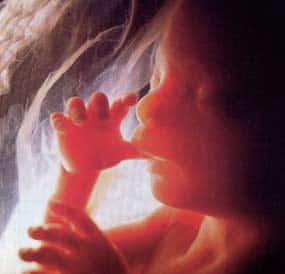
Ιωάννης Θαλασσινός, Διευθυντής Π.Ε.ΦΙ.Π. 04-10-2017
Ποιός ἄραγε θυμᾶται τή θλιβερή ἐπέτειο τῆς ψήφισης, ἀπό τή Βουλή τῶν Ἑλλήνων, τοῦ ἐπαίσχυντου...
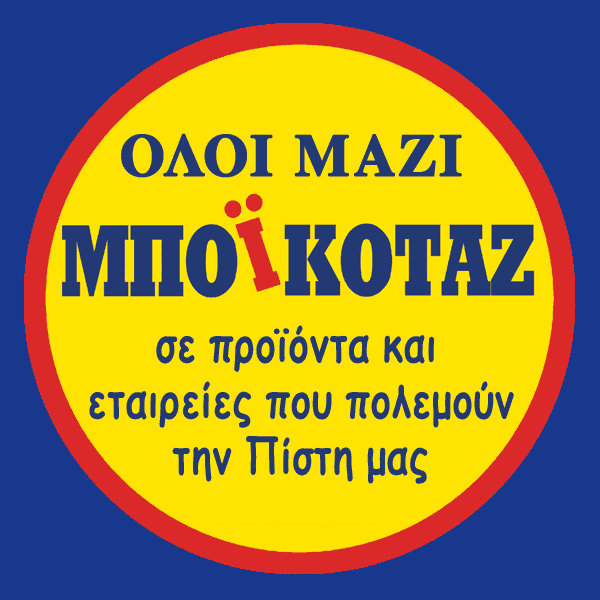
Χριστιανική Εστία Λαμίας 03-10-2017
Οἱ μάσκες ἔπεσαν γιά ἀκόμα μιά φορά. Ἑταιρεῖες γνωστές στούς Ἕλληνες καταναλωτές ἀφαίρεσαν ἀπό τά...
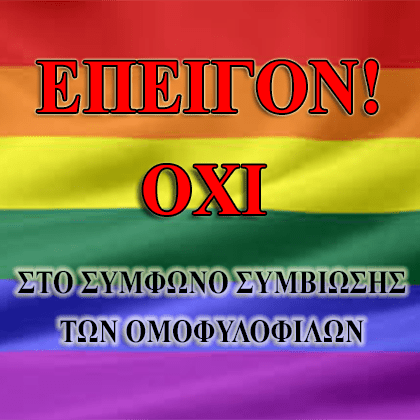
TIDEON 21-12-2015
Επιμένει να προκαλεί Θεό και ανθρώπους η ελληνική Κυβέρνηση, ψηφίζοντας στις 22 Δεκεμβρίου 2015 ως...

Tideon 14-12-2015
Η Κυβέρνηση μας μίλησε για την «αναγκαιότητα» και για τα πλεονεκτήματα της «Κάρτας του Πολίτη»...
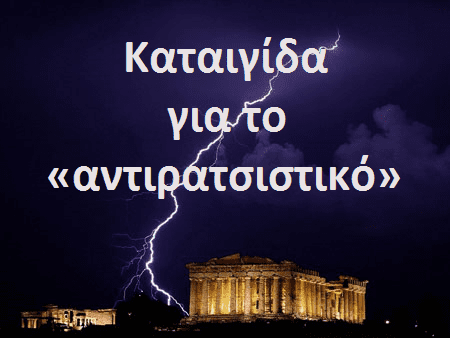
TIDEON 27-08-2014
Λαμβάνουν διαστάσεις καταιγισμού οι αντιδράσεις πλήθους φορέων και πολιτών για το λεγόμενο «αντιρατσιστικό» νομοσχέδιο το...
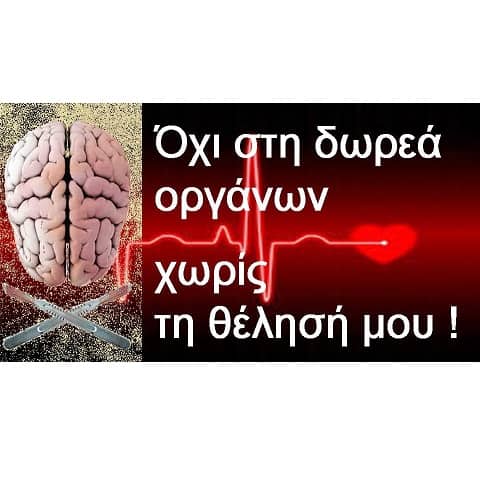
tideon.org 02-05-2013
Kαταθέτουμε την αρνητική δήλωση μας προς τον Εθνικό Οργανισμό Μεταμοσχεύσεων (ΕΟΜ). Ο νόμος αφήνει πολλά...

Tideon 31-12-2012
Ποια είναι η λύση αν πλήρωσες «τσουχτερές» τιμές στο Κυλικείο του Νοσοκομείου, του Αεροδρομίου, του...

Νικόλαος Ἀνδρεαδάκης, ὁδηγός 03-04-2012
Εἶμαι νέος μὲ οἰκογένεια, ἔχω ὅλη τὴ ζωὴ μπροστά μου… Λόγῳ ἐπαγγέλματος ἔχω τὴ δυνατότητα...
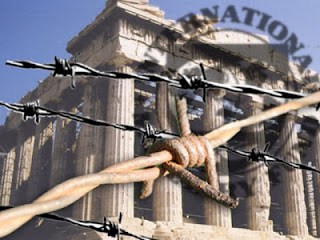
tideon 07-11-2011
ΜΝΗΜΟΝΙΟ: Δεν ξεχνώ αυτούς που παρέδωσαν αμετάκλητα και άνευ όρων την ΕΘΝΙΚΗ ΚΥΡΙΑΡΧΙΑ και έκαναν...

ΚΑΤΑΛΑΒΕΣ ΤΩΡΑ ... 15-02-2011
Κατάλαβες τώρα ... γιατί σε λέγανε «εθνικιστή» όταν έλεγες πως αγαπάς την Πατρίδα σου; Για να...

ΤΡΑΠΕΖΑ ΙΔΕΩΝ 25-12-2010
Τώρα πια γνωρίζω τους 10 τρόπους που τα ΜΜΕ μου κάνουν πλύση εγκεφάλου και πώς...